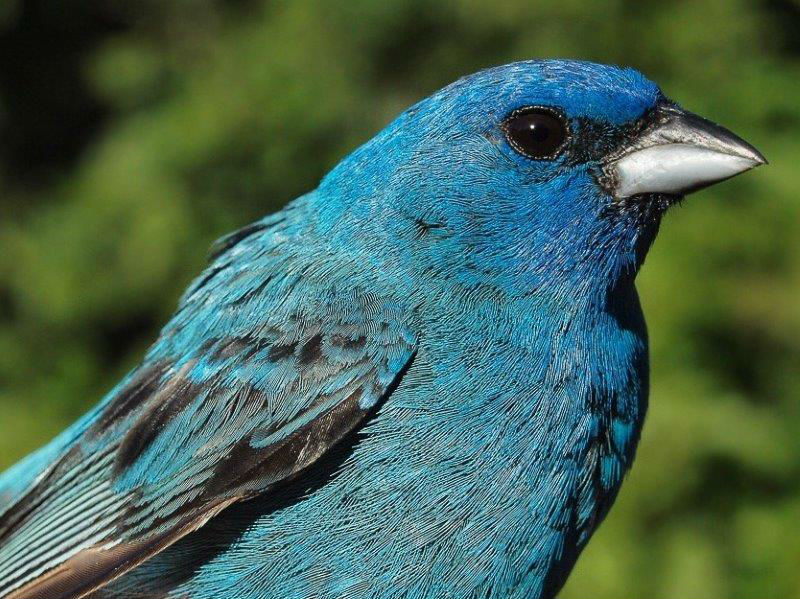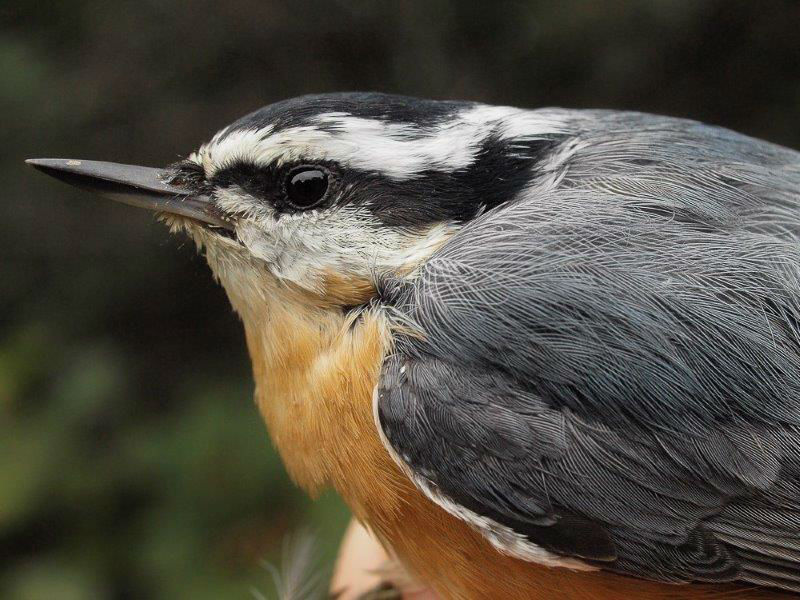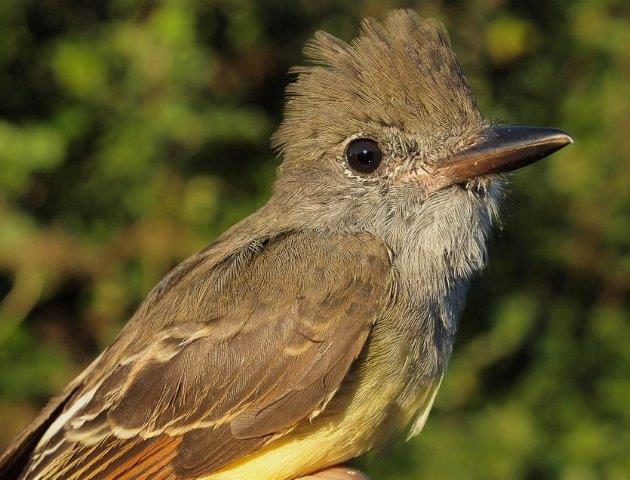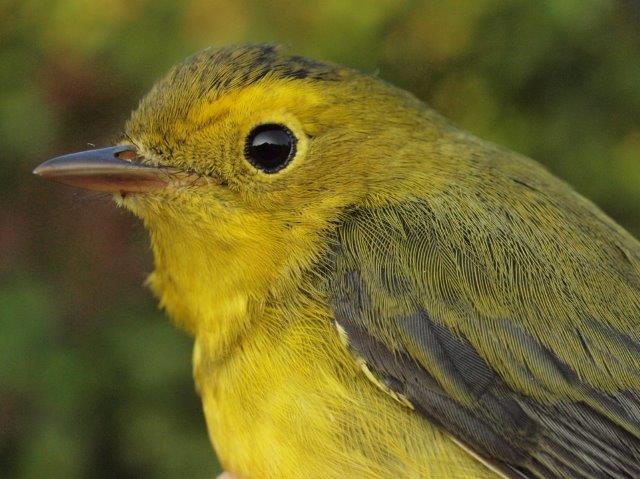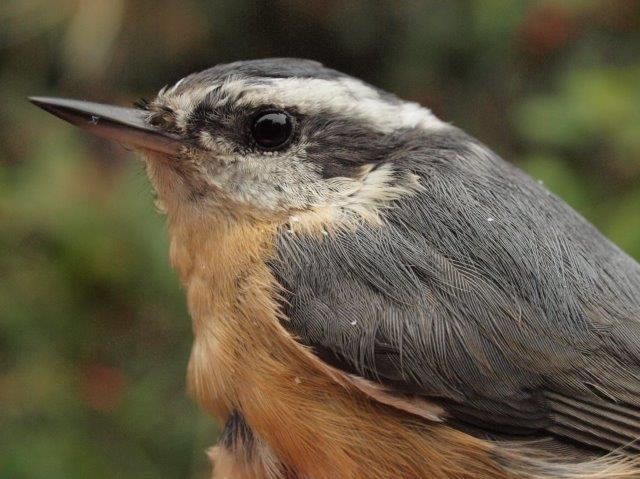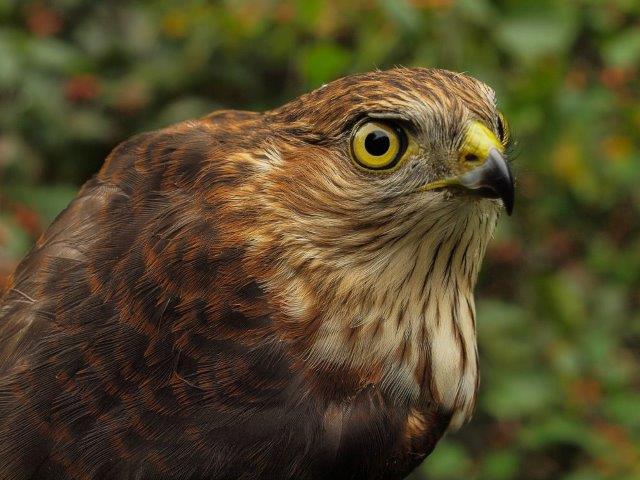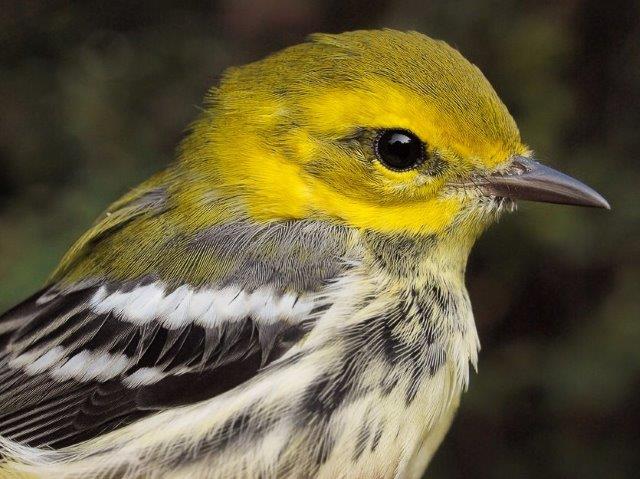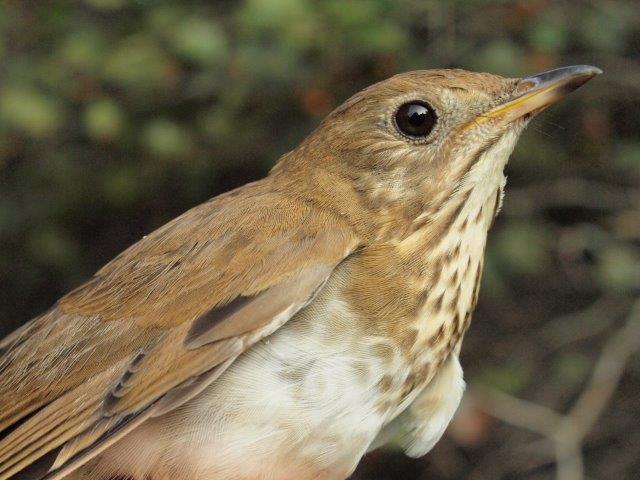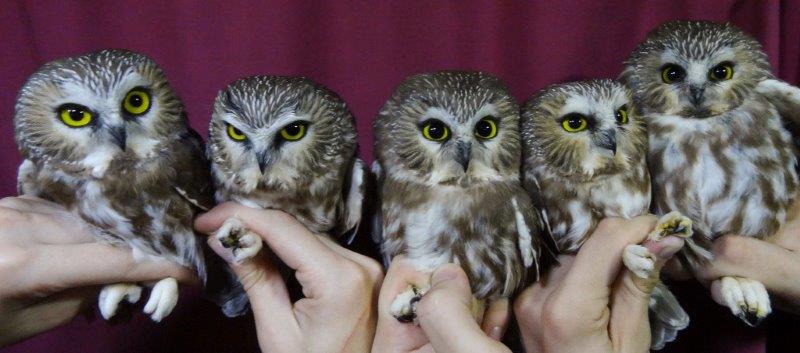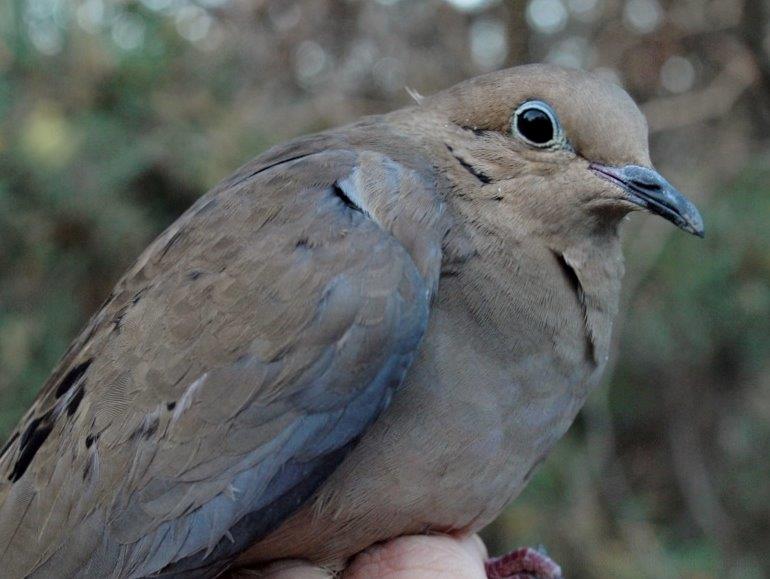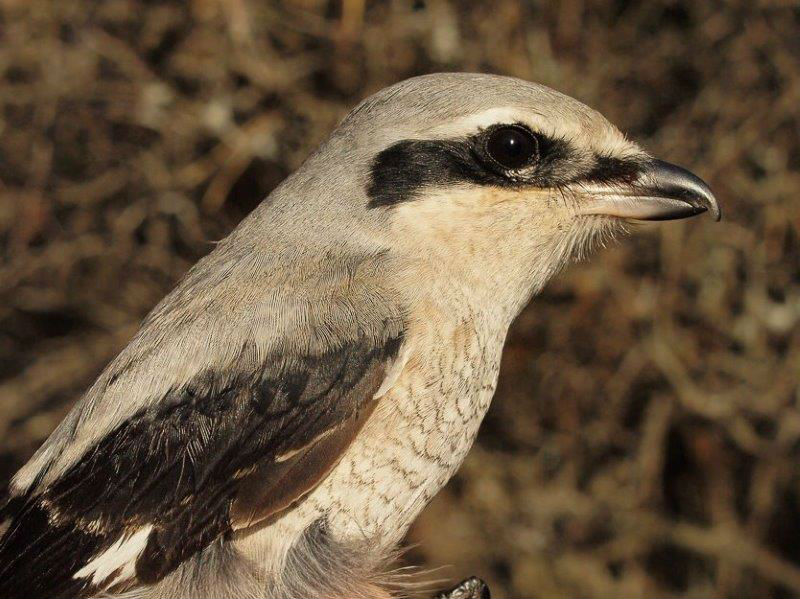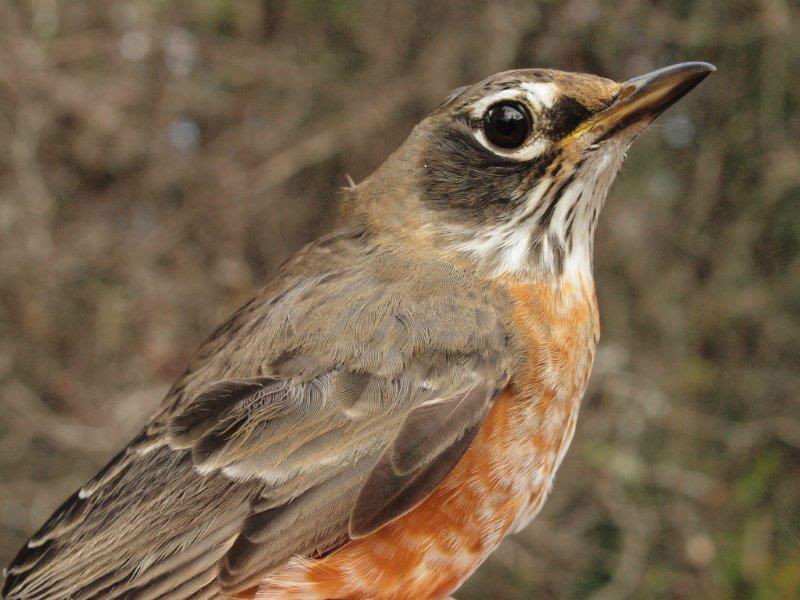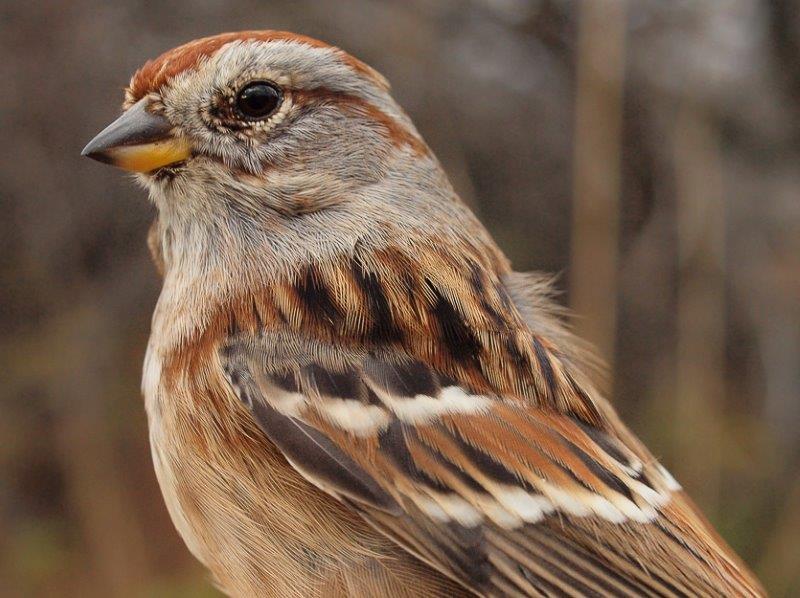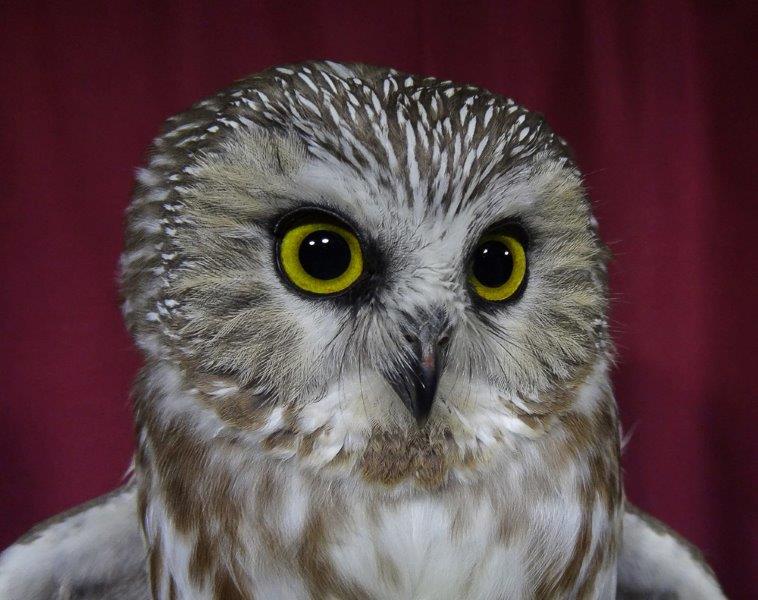Week 1 August 1-7
| THIS WEEK | THIS FALL | 2006 TOTAL | SITE TOTAL | |
|---|---|---|---|---|
| # birds (and species) banded | 233 (42) | 233 (42) | 1600(75) | 54807 (119) |
| # birds (and species) repeat | 54 (20) | 54 (20) | 325 (48) | 11026 (85) |
| # birds (and species) return | 7 (4) | 7 (4) | 121 (28) | 1793 (51) |
| # species observed | 83 | 83 | 149 | 213 |
| # net hours | 556.5 | 556.5 | 4046.8 | 106927.1 |
| # birds banded / 100 net hours | 41.9 | 41.9 | 39.5 | 51.1 |
Bander-in-charge:Simon Duval, Gay Gruner
Assistants: Nicolas Bernier, Pascal Berthelot, Alexander Boyer, Martha Bromby, Luke Currin, David Davey, Shannon Gailbraith, Alison Hackney, Lisa Keelty, Marcel Lebeau, Phillip Mercier, Catherine Russell, Lois Sauvé, Clémence Soulard, Patricia Stotland, Rodger Titman, Christiane Tremblay
Notes: Nicolas Bernier, Pascal Berthelot, Alexander Boyer, Martha Bromby, Luke Currin, David Davey, Shannon Gailbraith, Alison Hackney, Lisa Keelty, Marcel Lebeau, Phillip Mercier, Catherine Russell, Lois Sauvé, Clémence Soulard, Patricia Stotland, Rodger Titman, Christiane Tremblay
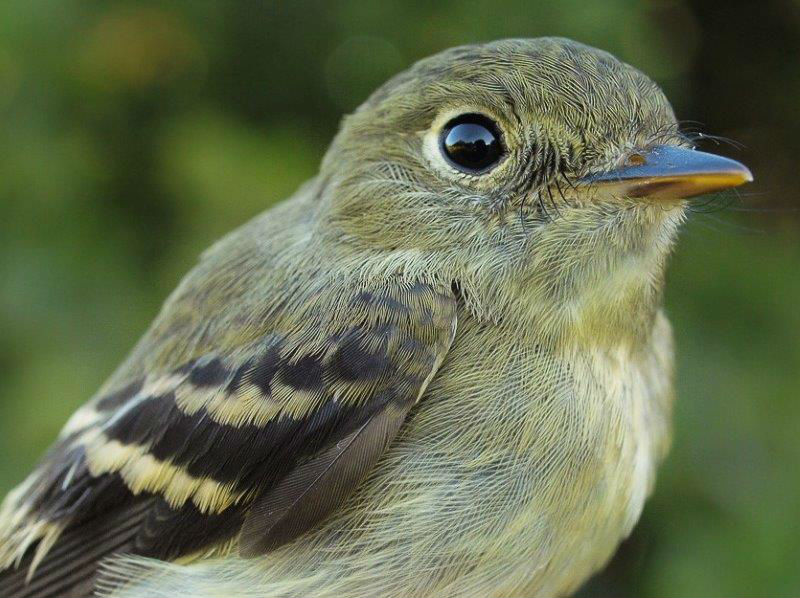
Fall counts of Yellow-bellied Flycatcher at MBO have been relatively good in recent years, with between 12 and 30 banded annually between 2008 and 2014; hopefully this is the first of many this fall. (Photo by Simon Duval)
Among the species observed this week was one new to MBO for the year, Spotted Sandpiper. We also banded three species for the first time in 2015: White-breasted Nuthatch, Blackburnian Warbler, and Black-throated Green Warbler.
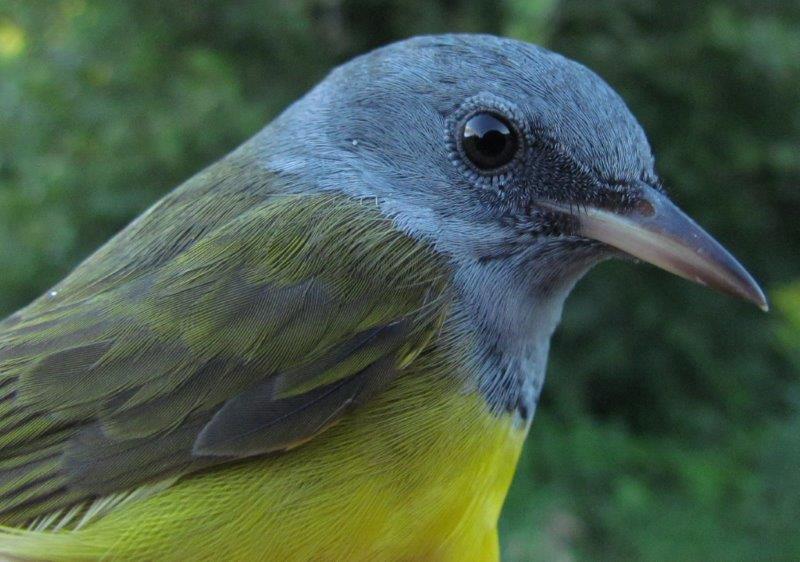
The most uncommon bird banded in the opening week was this Mourning Warbler; no more than 14 have been banded in any fall season. (Photo by Lisa Keelty)
A note about the cumulative totals presented in our summary table above – keen-eyed readers may have noticed that some of the site totals appear to be wrong. In fact, we have just completed a thorough review of all of our historical data as part of the preparation of our upcoming ten-year report, and in the process we identified a few errors that had slipped through. The numbers in the table above represent the corrected data.
| # individuals banded | mean # individuals observed daily |
|---|---|
| 1. American Redstart (34) | 1. Common Grackle (22) |
| 2. Song Sparrow (30) | 2. American Crow (21) |
| 3. Gray Catbird (17) | 3. American Robin (19) |
| 4. Ovenbird (13) | 4. Cedar Waxwing (14) |
| 5. Yellow Warbler (12) | 5. American Goldfinch (12) |
| 6. Common Yellowthroat (9) | 6. Song Sparrow (12) |
| 7. Red-eyed Vireo (8) | 7. Black-capped Chickadee (11) |
| 8. Veery (7) | 8. Blue Jay (10) |
| 9. Black-capped Chickadee (6) 9. Canada Warbler (6) 9. Black-and-white Warbler (6) |
9. Gray Catbird (9) 9. American Redstart (9) |
For the second year in a row, American Redstart was the most frequently banded species in the first week of fall, followed by Song Sparrow (in fact, numbers are very similar to 2014, when we banded 29 American Redstarts and 26 Song Sparrows). Although by a small margin, this again represents a new record count for American Redstart in week 1, and further underlines the trend we have been observing of this species migrating earlier, year after year. Gray Catbird was in third place this week, also the same as last year at this time. On the other hand, we were surprised to band 13 Ovenbirds, as they have only once previously been in the top ten in week 1 (in 2006), and with only 4 individuals at that! Is this a sign of a big season to come for them, or is this species just moving early this year? Yellow Warbler numbers rebounded a bit from last year’s record low of 7, but were again far below the ten-year mean of 24 for the opening week. The rest of the top ten (including a three-way tie for 8th place) was rounded out by species that are mostly local breeders, although some of the Black-and-white Warblers may be early migrants.
Common Grackle was a bit of a surprise as the most numerous bird of the week, having been the top species in week 1 only once previously in 2009, and more typically with daily mean counts of 5-15 at this time of year. On the other hand, Red-winged Blackbird has been the top species in three of the past ten years, but didn’t even crack the top ten this year (the mean daily count was only 7). Overall, this week’s list largely reflects the dominance of locally breeding species typical of the early part of our fall season, with the arrival of American Redstarts the only notable exception.
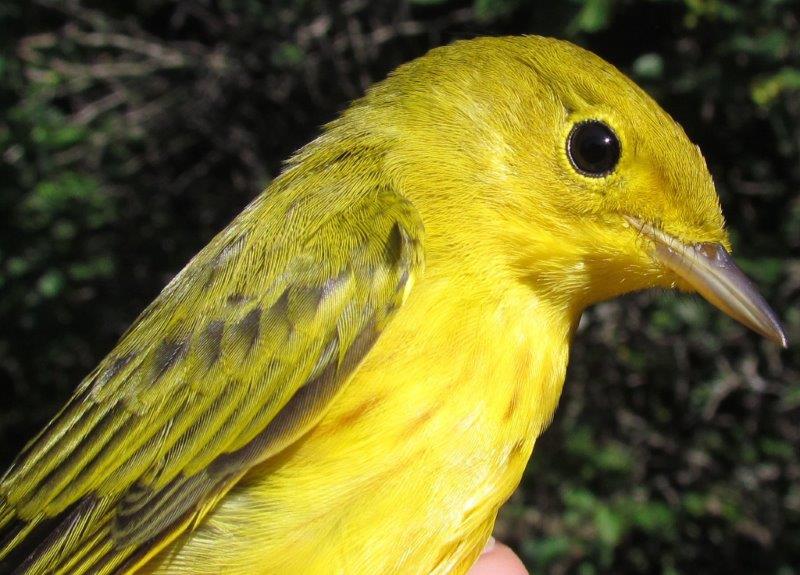
Although it is only the first week of August, we will soon be saying goodbye to Yellow Warblers, one of the earliest species to head south. (Photo by Lisa Keelty)
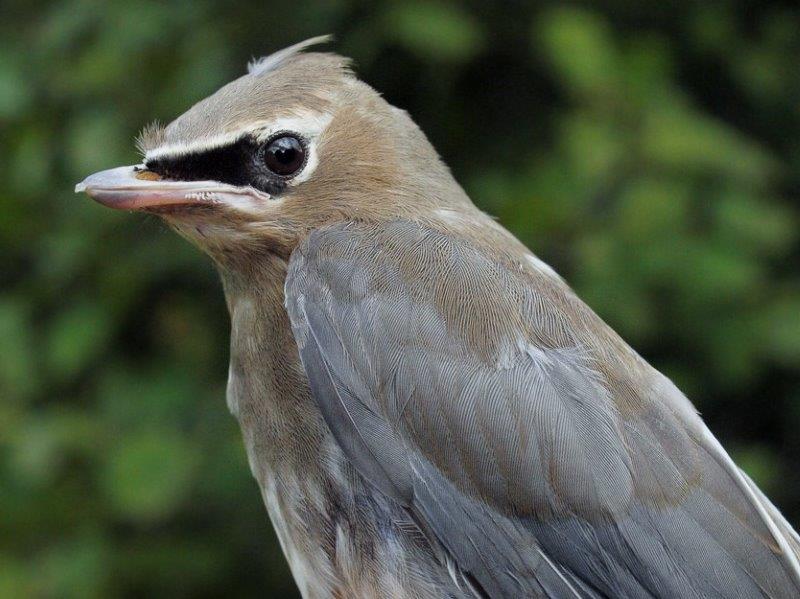
While Yellow Warblers are already getting ready to migrate, juveniles of other species such as Cedar Waxwing are just now fledging. (Photo by Simon Duval)
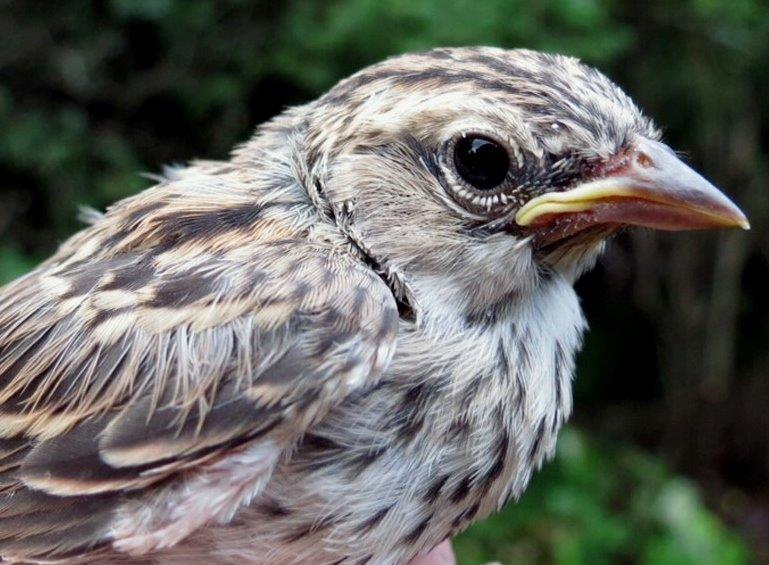
Roger Tory Peterson popularized the term “confusing fall warblers” – but what about juvenile sparrows? This very young bird is a Chipping Sparrow, with its streaky underparts quite unlike its parents! (Photo by Gay Gruner)
Week 2 August 8-14
Bander-in-charge: Simon Duval, Gay Gruner, Lisa Keelty
Assistants: Nicolas Bernier, Pascal Berthelot, Alexander Boyer, David Davey, Shannon Gailbraith, Lisa Keelty, Tom Kingsbury, Laura Torres, Marcel Lebeau, Barbara MacDuff, Phillip Mercier, Benoît Piquette, Loic Sauvé, Clémence Soulard, Christiane Tremblay, Jesse White
Notes: Every year since 2007, the banding total in the second week of fall has been lower than in the first week, and this year the drop was substantial (although influenced a fair bit by rain, which cancelled banding on one morning and reduced effort considerably on two others). The 146 birds banded this week was the fewest for the period since 2011. However, observations for the week remained well above average, with 81 species compared to a ten-year mean of 73.
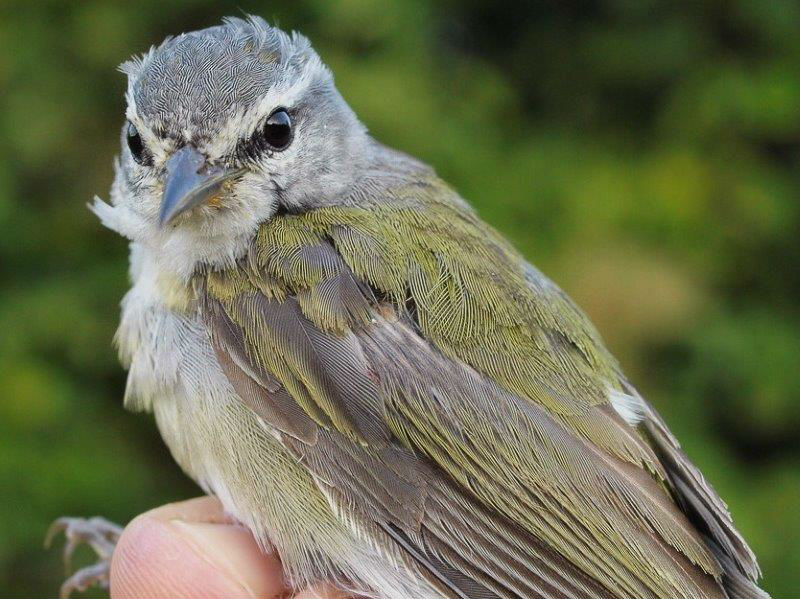
Another impressive bird in week 2 was this Tennessee Warbler, captured 2 years and 359 days after we banded it – and in net D1 both times! Tennessee Warblers do not breed at MBO, but a fair number molt here every fall, and this is another example of a molt migrant showing site fidelity. (Photo by Simon Duval)
Even though it was a quieter week of banding, we added five new species for fall – Red-breasted Nuthatch, Tennessee Warbler, Cape May Warbler, Magnolia Warbler, and American Goldfinch. Among the nine species observed for the first time this fall was a quartet of raptors (Cooper’s Hawk, Northern Goshawk, Red-shouldered Hawk, and Red-tailed Hawk), the aforementioned nuthatch and two of the warblers (Cape May and Magnolia), as well as Scarlet Tanager and Bobolink. The goshawk was our only new bird for 2015, and came unusually early (only four previous records in the first half of August over ten years).
| # individuals banded | mean # individuals observed daily |
|---|---|
| 1. American Redstart (28) [1] | 1. American Crow (19) [2] |
| 2. Swainson’s Thrush (14) [-] | 2. American Goldfinch (17) [5] |
| 3. Rose-breasted Grosbeak (8) [-] | 3. Cedar Waxwing (14) [4] |
| 4. Black-capped Chickadee (7) [9] | 4. Black-capped Chickadee (11) [7] |
| 4. Gray Catbird (7) [3] | 5. American Redstart (11) [9] |
| 4. Ovenbird (7) [4] | 6. Blue Jay (10) [8] |
| 7. Black-and-white Warbler (6) [9] | 7. American Robin (10) [3] |
| 7. Song Sparrow (6) [2] | 8. Common Grackle (8) [1] |
| 9. Cedar Waxwing (5) [-] | 9. Gray Catbird (8) [9] |
| 9. Common Yellowthroat (5) [6] 9. Yellow Warbler (5) [5] 9. Canada Warbler (5) [-] |
10. European Starling (7) [-] |
American Redstart was the most frequently banded bird for the second week in a row – not surprising as this marks the fifth time in the past seven years that it has been on top in week 2. More unexpected was seeing Swainson’s Thrush as the runner-up, with more birds banded this week (14) than in week 2 in all ten previous years combined (11)! Of note, 9 of the 11 previous records were in 2012 – the same year that the fall total of 176 Swainson’s Thrushes shattered the previous high of 36. We are therefore most curious to see whether we are in for another high total as this season progresses. To date, all of the birds banded have been moulting adults, which is the norm for August arrivals at MBO. Rose-breasted Grosbeak is often in the top ten at this point in fall, but only once previously (in 2006) reached the top three. Offspring of the local Black-capped Chickadees were banded in fair numbers again this week, and the strong early season counts of Gray Catbird and Ovenbird also continued. While Song Sparrow has five times been the most numerous bird banded in week 2, it only eked into the bottom half of this week’s top ten, with just half as many as the previous low count for the period of 12, back in 2008.
Common Grackle numbers dropped off this week, while American Crow, American Goldfinch, and Cedar Waxwing all increased to become the top three species observed, although in rather modest numbers. Black-capped Chickadee and American Redstart rounded out the top five, reflecting their presence in the banding list, but the Blue Jays being observed have so far largely avoided the nets (only 2 banded to date this fall). Historically there has been relatively little pattern to dominance in week 2, with six different species taking top spot over ten years, although 2015 marks the fourth time that it has been occupied by American Crow (2005, 2007, 2010, 2015), once more than Common Grackle (2008, 2009, 2012).
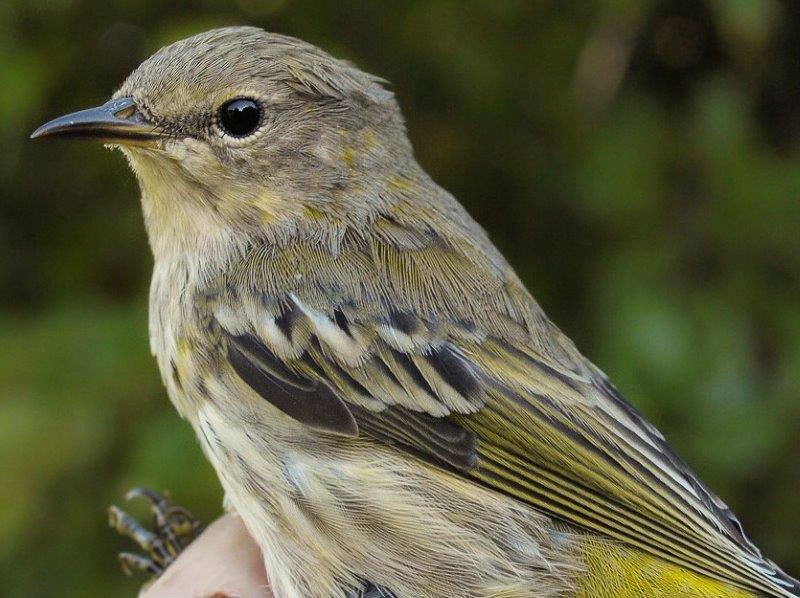 In 2011 and 2013 we saw strong spikes in Cape May Warbler numbers, presumably in response to the spruce budworm outbreak in Quebec, although in 2012 and 2014 the counts were more modest. Are we in for another high year in 2015? (Photo by Simon Duval) 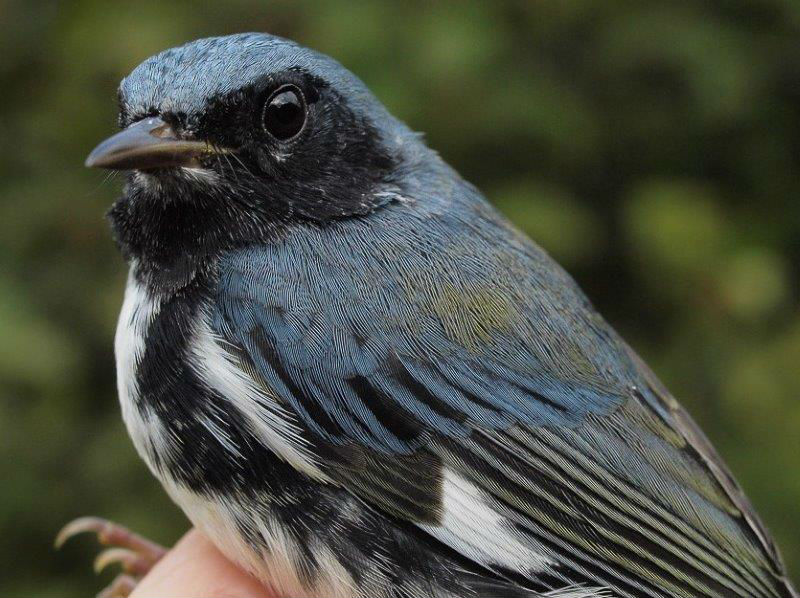 Black-throated Blue Warblers are among the few warblers that typically are present for at least two-thirds of the fall season at MBO. However, the peak of their migration is on average around mid-September, so it’s always nice to see one early in the season (Photo by Simon Duval)
|
Week 3 August 15-21
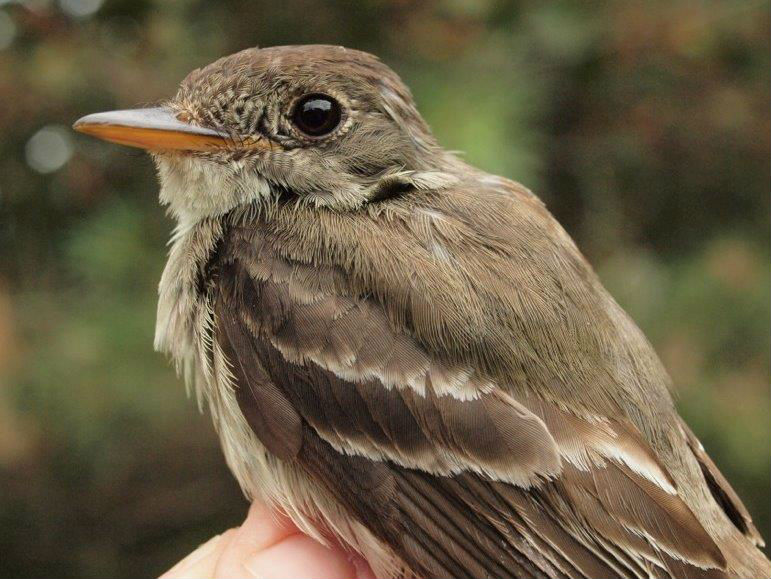 To commemorate our 11th year of standardized migration monitoring at MBO, here is our 11th Eastern Wood-Pewee banded over that period (Photo by Simon Duval)
|
Bander-in-charge: Simon Duval, Marcel Gahbauer, Gay Gruner, Lisa Keelty
Assistants: Pascal Berthelot, Manon Bourdon, Martha Bromby, Luke Currin, David Davey, Shannon Gailbraith, Nathalie Gendron, Nicole Guido, Frédéric Hareau, Tom Kingsbury, Barbara MacDuff, Phillip Mercier, Benoît Piquette, Catherine Russell, Clémence Soulard, Patricia Stotland, Elise Titman, Rodger Titman, Christiane Tremblay, Jesse White
Notes: Often the lull in numbers that strikes in week 2 of fall continues through week 3, but this year was a happy exception to that pattern. In fact, the 232 birds banded this week was the second-highest total ever for this period, behind only the 250 recorded in week 3 of 2010 – and the 44 species banded was in fact a new record, a good jump up on the 41 at this point in 2012. Another 44 species were observed only, and the total of 88 was also well above average for the week, although well short of the record of 94 for this week, set in 2013. The season total to date of 100 species observed is also a bit short of where we were at this point over the past three years (101 to 107), but slightly above the long-term mean for the period.
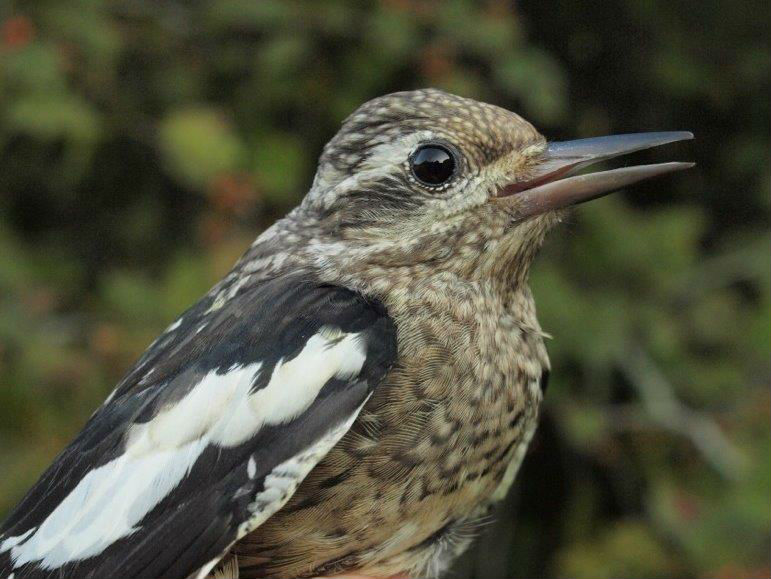
Another relatively uncommon species at MBO is Yellow-bellied Sapsucker, with only 3 or 4 individuals banded in an average year; this juvenile was the first of fall 2015. (Photo by Simon Duval)
The eight species banded in week 3 that were new for fall 2015 were a varied bunch: Black-billed Cuckoo, Yellow-shafted Flicker, Eastern Wood-Pewee, Eastern Phoebe, Blue-headed Vireo, Bay-breasted Warbler, Scarlet Tanager, and House Finch. Four of these species (the cuckoo, pewee, tanager, and finch) were new for 2015 overall. The eight new species observed this week skewed more heavily toward the non-passerines: Broad-winged Hawk, Solitary Sandpiper, Wilson’s Snipe, Common Tern, Belted Kingfisher, American Kestrel, Olive-sided Flycatcher, and Bay-breasted Warbler. Although Olive-sided Flycatcher is a rare migrant at MBO (only 12 previous fall records over 12 years), it is remarkably consistent in timing, with two-thirds of those records occurring between August 13 and 20; this year’s bird fell right in the middle of that span, on August 17, and was also the first of 2015 overall.
| # individuals banded | mean # individuals observed daily |
|---|---|
| 1. American Redstart (42) [1] | 1. American Goldfinch (22) [2] |
| 2. Song Sparrow (21) [7] | 2. Canada Goose (22) [-] |
| 3. Cape May Warbler (15) [-] | 3. American Crow (17) [1] |
| 4. Common Yellowthroat (14) [9] | 4. Red-winged Blackbird (15) [-] |
| 4. Canada Warbler (14) [9] | 5. Common Grackle (13) [8] |
| 4. Rose-breasted Grosbeak (14) [3] | 6. Black-capped Chickadee (12) [4] |
| 7. Ovenbird (9) [4] | 7. American Robin (11) [7] |
| 8. Black-and-white Warbler (8) [7] | 8. American Redstart (10) [5] |
| 8. Mourning Warbler (8) [-] | 9. Blue Jay (8) [6] |
| 10. Red-eyed Vireo (6) [10] 10. Gray Catbird (6) [4] 10. Chestnut-sided Warbler (6) [-] 10. American Goldfinch (6) [-] |
10. Cedar Waxwing (7) [3] |
For a second consecutive year, American Redstart has been the top species banded for the first three weeks of fall – and for the second straight week, their count is double that of the closest runner-up. Although the peak of American Redstart migration has been advancing over the years, week 3 represents the long-term average peak, and this is the 7th time in 11 years that it has been the top species for the week. The only exceptions were Song Sparrow (2005, 2006, and 2009), which was in second place this week, and Common Yellowthroat (2012), tied for fourth this week with unusually high numbers of Canada Warbler (second-highest ever single week total, after 16 in week 3 of 2010) and Rose-breasted Grosbeak (best weekly total since 15 in week 4 of fall 2012). Both Ovenbird and Black-and-white Warbler have maintained above-average numbers throughout the first three weeks of fall and may be on the way to new records for the season if the pattern continues. Also particularly impressive was the count of 8 Mourning Warblers, a new single-week record, and only the fourth time in 11 years of operation that we have banded enough of them in a week to appear in a weekly top ten summary.
American Goldfinch barely edged out Canada Goose (separated by decimal points – four more goldfinches were observed over the course of the week) for top species observed at MBO in week 3. While goldfinches are always common at MBO at this time of year (ranked between second and fourth in 9 of 10 previous fall programs), this is the first time they have topped the list. Meanwhile it is unusually early in fall for Canada Geese to be showing up in any numbers, with only two previous occurrences in the top ten for week 3. However, those were in 2012 and 2013, suggesting that these early arrivals might be turning into a pattern. Otherwise, the top ten this week largely includes the same species as last week (mostly local residents) although the sequence has been juggled a bit; the other new addition this week was Red-winged Blackbird, while Gray Catbird and European Starling dropped off from week 2’s list.
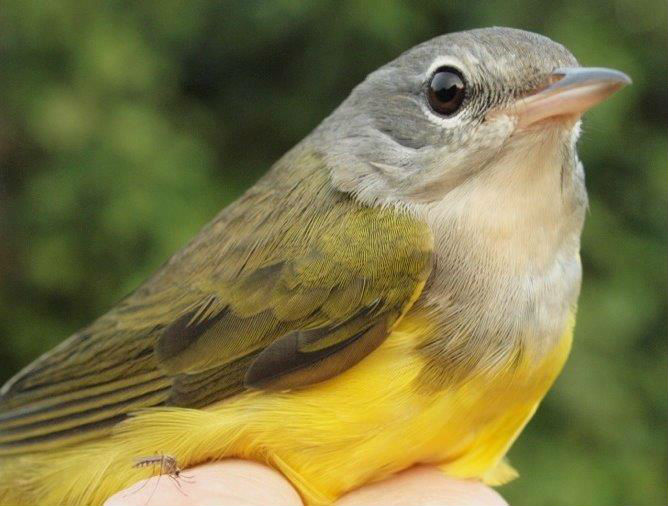
Generally a relatively uncommon species at MBO, this was one of 8 Mourning Warblers banded at MBO this week, a new single-week record (Photo by Simon Duval)
Week 4 August 22-28
[
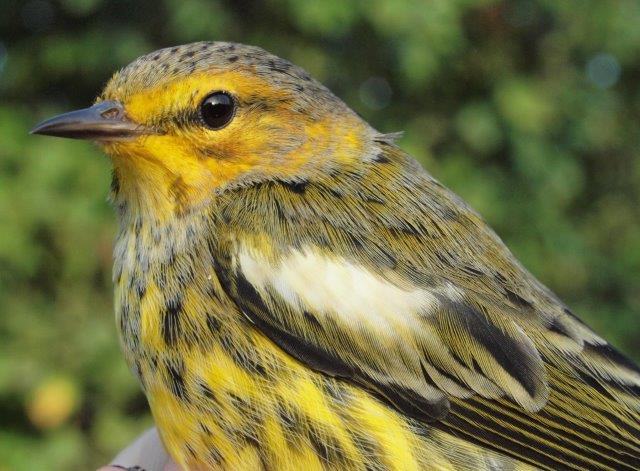 ack in August 2006, we documented a number of unusually reddish Baltimore Orioles, eventually leading to a research paper on the subject. We have seen fewer such individuals in recent years, but the one above from this week is as boldly coloured as any we have seen. (Photo by Simon Duval) ] |
| THIS WEEK | THIS FALL | 2006 TOTAL | SITE TOTAL | |
|---|---|---|---|---|
| # birds (and species) banded | 220 (40) | 831 (57) | 2198 (81) | 55405 (119) |
| # birds (and species) repeat | 50 (18) | 198 (30) | 469 (53) | 11170 (85) |
| # birds (and species) return | 8 (6) | 32 (15) | 146 (31) | 1818 (51 |
| # species observed | 87 | 108 | 152 | 213 |
| # net hours | 560.0 | 2077.4 | 5567.7 | 108448.0 |
| # birds banded / 100 net hours39.3 | 39.3 | 40.0 | 39.5 | 50.9 |
Bander-in-charge: Simon Duval, Gay Gruner.
Assistants: Michel Beaupré, Johannie Bernard, Pascal Berthelot, Marc Boisvert, Marie-France Boudreault, Manon Bourdon, Martha Bromby, Claude Cloutier, Marcel Gahbauer, Shannon Gailbraith, Nicole Guido, Alison Hackney, James Junda, Lisa Keelty, Tom Kingsbury, Barbara MacDuff, Phillip Mercier, Benoît Piquette, Francine Piquette, Clémence Soulard, Patricia Stotland, Elise Titman, Rodger Titman, Christiane Tremblay, Jesse White.
Notes: After the spike in migration last week, activity slowed down a bit this week, in contrast to the typical pattern of numbers picking up in week 4 of fall. Despite full coverage this week, the number of birds was lower than in any of the previous four years – although higher than in any of the first six years of operation! The season total to date remains somewhat above average, ranking fourth out of 11 seasons. The 87 species observed this week is a new high for week 4, one better than last year, and most notably, the 70 species observed on August 22 was a new single-day record for fall, shattering the previous high of 65 from September 25, 2013 (although still well short of the all-season record of 76 from May 20, 2014). Overall, the season total of 108 after four weeks is only a bit above average..
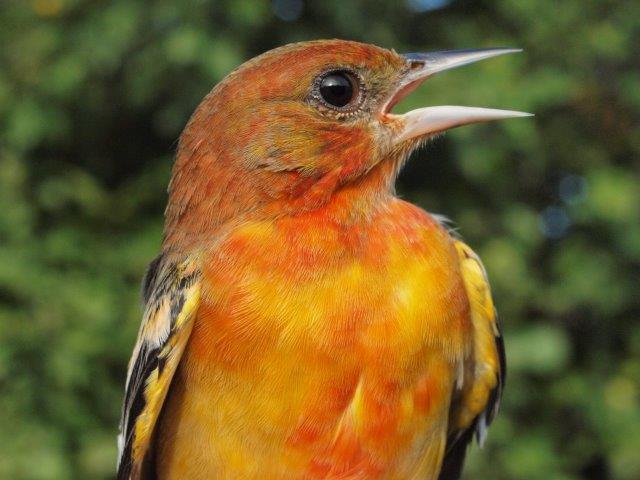
Back in August 2006, we documented a number of unusually reddish Baltimore Orioles, eventually leading to a research paper on the subject. We have seen fewer such individuals in recent years, but the one above from this week is as boldly coloured as any we have seen. (Photo by Simon Duval)
Like last week, another 8 species were observed for the first time this fall: American Black Duck (the first of 2015 overall), Common Loon, Double-crested Cormorant, Osprey, Bald Eagle, Cliff Swallow, Winter Wren (unusually early, only the fourth August record in MBO’s history), and Wilson’s Warbler. One species, Great Crested Flycatcher, was banded for the first time in 2015, and one other, Wilson’s Warbler, for the first time this fall.
| # individuals banded | mean # individuals observed daily |
|---|---|
| 1. Magnolia Warbler (42) [-] | 1. American Crow (35) [3] |
| 2. American Goldfinch (23) [10] | 2. Common Grackle (33) [5] |
| 3. American Redstart (22) [1] | 3. American Goldfinch (27) [1] |
| 4. Common Yellowthroat (16) [4] | 4. American Robin (18) [7] |
| 5. Northern Waterthrush (13) [-] | 5. Black-capped Chickadee (13) [6] |
| 5. Song Sparrow (13) [2] | 6. Cedar Waxwing (13) [10] |
| 7. Gray Catbird (11) [10] | 7. Canada Goose (12) [2] |
| 8. Ovenbird (9) [7] | 8. Blue Jay (11) [9] |
| 8. Yellow-bellied Flycatcher (8) [-] | 9. American Redstart (9) [8] |
| 10. Cape May Warbler (7) [3] | 10. Gray Catbird (8) [-] |
Although Magnolia Warblers were barely present last week, they dominated this week’s banding efforts, and right on schedule – this was the 8th time in 11 years that Magnolia Warbler was the top species in week 4, the only exceptions being 2009 (Song Sparrow) and the past two years when Tennessee Warblers (conspicuously scarce this week, with only 5 individuals banded) outnumbered them. More surprising was the influx of American Goldfinches in second place, as this species has only twice previously been in the top ten at this point in the season (7 individuals in 2006, 12 in 2013). After topping the banding list for the first three weeks of the season, American Redstart slipped to third place – the seventh time in the past nine years it has been in the top three for week 4. Common Yellowthroat and Northern Waterthrush are also often among the top five at this point in the season, so their numbers were to be expected. Song Sparrows have tapered off a bit since last week, while Gray Catbird numbers increased to a record level for week 4. Ovenbirds remained in good numbers for another week, while Cape May Warblers started to taper off, and we had a nice little late August influx of Yellow-bellied Flycatchers.
With respect to observations, American Crow narrowly edged out Common Grackle for top spot this week, followed relatively closely by American Goldfinch; all three species are typically among the top five for this period. The next trio of American Robin, Black-capped Chickadee, and Cedar Waxwing are also among the regular species dominating in late August. Canada Goose, although in lower numbers than last week, remained a bit of a surprise, as it has only twice previously been among the top ten species during week 4. Rounding out the list are three more usual suspects for this time of fall – Blue Jay, American Redstart, and Gray Catbird.
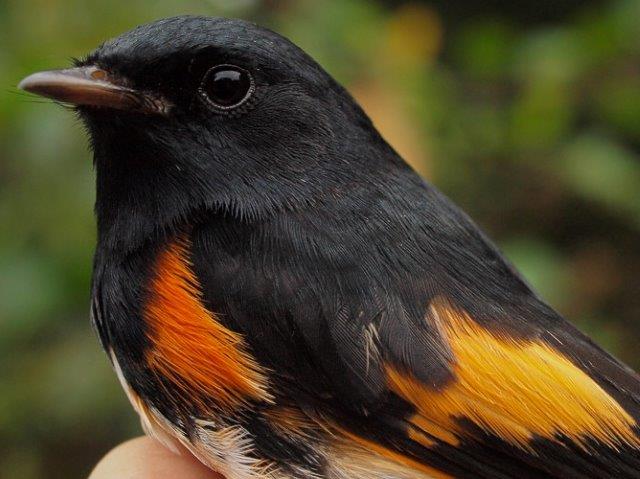 While American Redstart numbers are starting to taper off a bit after a dominant start to fall 2015, we are still banding them almost daily, including this handsome after-hatch-year male (Photo by Simon Duval) |
Week 5 August 29 – September 4
[
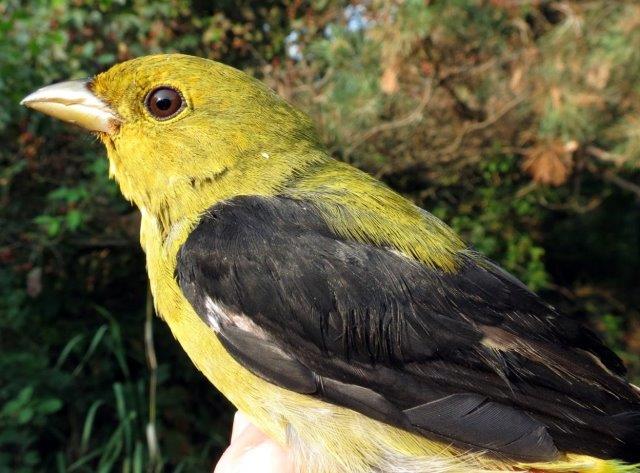 Although Scarlet Tanagers are banded in small numbers at MBO each fall (26 over the past 10 years), this was the first adult ever! Moreover, it is still recognizable as a second-year bird by virtue of a retained brown juvenile secondary (Photo by Gay Gruner) ] |
| THIS WEEK | THIS FALL | 2006 TOTAL | SITE TOTAL | |
|---|---|---|---|---|
| # birds (and species) banded | 188 (39) | 1019 (59) | 2386 (81) | 55593 (119) |
| # birds (and species) repeat | 56 (21) | 254 (32) | 525 (54) | 11226 (85) |
| # birds (and species) return | 3 (3) | 35 915) | 149 (31) | 1821 (51) |
| # species observed | 78 | 115 | 153 | 213 |
| # net hours | 560.0 | 2637.4 | 6127.7 | 109008.0 |
| # birds banded / 100 net hours | 33.6 | 38.6 | 38.9 | 50.0 |
Bander-in-charge: Simon Duval, Gay Gruner, Lisa Keelty.
Assistants: Angelika Aleksieva, Richard Beauchamp, Michel Beaupré, Pascal Berthelot, Manon Bourdon, Martha Bromby, Louise Courtemanche, Luke Currin, David Davey, Liete Fortier, Shannon Gailbraith, Nicole Guido, Alison Hackney, Frédéric Hareau, Lisa Keelty, Tom Kingsbury, Marcel Lebeau, Barbara MacDuff, Phillip Mercier, Anita Morales, Catherine Russell, Patricia Stotland, Mireille Terrault, Elise Titman, Rodger Titman, Christiane Tremblay, François Villeneuve.
Notes: The level of bird activity in week 5 varies a fair bit from year to year, and 2015 seems to have been closer to the middle of the spectrum, with more birds banded than 4 previous years, but fewer than the other six years; similarly the total for the season after five weeks is lower than any of the last five years, but higher than in any of the five years before that. As such, what feels slow on site may be more truly average over the long-term, but seems that way after the above-average starts to fall migration in recent years. The continuing hot weather may well be a factor in holding back migration. Where this week was truly below average was with respect to the number of species observed, with 78 just above the record low of 76 for this period, and well below the high of 93. That being said, with 7 new species for the season observed this week despite the lull, the fall 2015 total is up to 115, just a single species behind the record pace from 2013. With another two months of migration still ahead of us, it’s far too early to tell what the overall picture will end up looking like!.
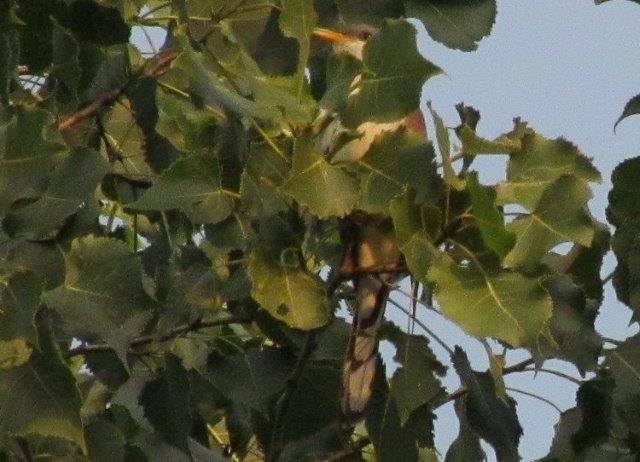
Although we were not able to band it, we at least had a nice look at MBO’s sixth Yellow-billed Cuckoo record in 11 years, and the first since September 2013 (Photo by Lisa Keelty)
Yellow-billed Cuckoo was the only species this week that was newly observed for 2015, but an additional six species were new for this fall: Northern Harrier, Peregrine Falcon, American Woodcock, Phialdelphia Vireo, Blackpoll Warbler, and Yellow-rumped Warbler. The list of species banded this fall grew by only two over the past week, with the addition of Yellow-rumped Warbler on September 1, and Sharp-shinned Hawk the next day.
| # individuals banded | mean # individuals observed daily |
|---|---|
| 1. American Goldfinch (20) [2] | 1. Common Grackle (63) [2] |
| 2. Red-eyed Vireo (18) [-] | 2. American Goldfinch (38) [3] |
| 3. American Redstart (16) [3] | 3. American Crow (18) [1] |
| 3. Magnolia Warbler (16) [1] | 4. Canada Goose (18) [7] |
| 5. Common Yellowthroat (13) [4] | 5. Black-capped Chickadee (15) [5] |
| 6. Gray Catbird (11) [7] | 6. Cedar Waxwing (14) [6] |
| 6. Song Sparrow (11) [5] | 7. American Robin (14) [4] |
| 8. Tennessee Warbler (10) [-] | 8. Blue Jay (14) [8] |
| 9. Swainson’s Thrush (7) [-] | 9. Gray Catbird (8) [10] |
| 9. Veery (7) [-] | 10. Red-eyed Vireo (8) [-] |
Last week’s unexpectedly large number of American Goldfinches banded was no fluke – nearly as many were banded this week, and with other migrants dropping in abundance, it was enough for them to take over the top spot – especially noteworthy as (like for week 4), they had only appeared among the top ten for this week in two of ten previous years. However, in this case those years were 2013 and 2014, suggesting a potential trend of increasing abundance. Red-eyed Vireo abundance commonly increases at this point in fall, and sure enough they suddenly arrived in good numbers this week. American Redstart and Magnolia Warbler tied for third place; while we are past the peak of American Redstart migration, the relatively low number of Magnolia Warblers is a bit surprising as this species topped the list of species banded in week 5 annually from 2005 through 2012, often by a wide margin) and was runner-up in 2013 and 2014. Common Yellowthroat, Gray Catbird, and Song Sparrow were close to repeating last week’s numbers. Tennessee Warblers finally started to show up in somewhat better numbers this week, but far short of what we banded in week 5 the past two years (87 in 2013 and 47 in 2014). Rounding out this week’s top ten were two thrushes in well-above average numbers for this point in the season – Swainson’s Thrush and Veery.
For the sixth time since 2005, Common Grackle was the most numerous species observed in week 5. American Goldfinch and American Crow remained among the top three for a second week in a row, while Canada Goose rebounded and Black-capped Chickadee held steady in fifth place. Also relatively consistent in the middle and lower parts of the top ten were Cedar Waxwing, American Robin, Blue Jay, and Gray Catbird; the only notable change from last week was that American Redstart dropped out, replaced by Red-eyed Vireo.
Week 6 September 5-11
[
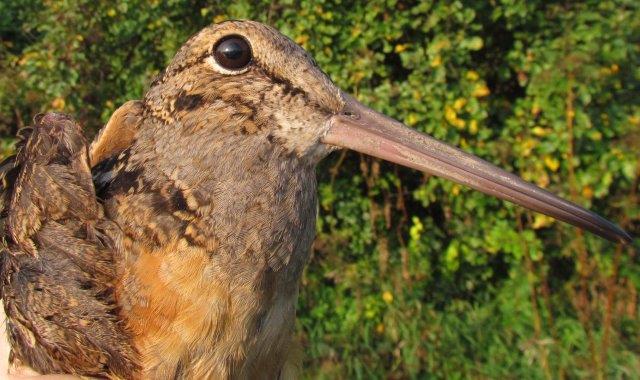 The highlight of the week was this American Woodcock, only the third one ever banded at MBO, but the second this year! (Photo by Lisa Keelty) ] |
| THIS WEEK | THIS FALL | 2006 TOTAL | SITE TOTAL | |
|---|---|---|---|---|
| # birds (and species) banded | 185.36 | 2104.63 | 2571.82 | 55778 (119) |
| # birds (and species) repeat | 44 916) | 298 (33) | 569 (55) | 11270 (85) |
| # birds (and species) return | 5 (4) | 40 916) | 154 (31) | 1826 (51) |
| # species observed | 81 | 117 | 153 | 213 |
| # net hours | 545.8 | 3183.2 | 6673.5 | 109553.8 |
| # birds banded / 100 net hours | 33.9 | 37.8 | 38.5 | 50.8 |
Bander-in-charge: Simon Duval, Gay Gruner
Assistants: Michel Beaupré, Pascal Berthelot, Alexander Boyer, Martha Bromby, David Davey, Stéfany Desroches, Shannon Gailbraith, Nicole Guido, Alison Hackney, Frédéric Hareau, Lisa Keelty, Tom Kingsbury, Marcel Lebeau, Catherine Legault, Francine Marcoux, Betsy McFarlane, Phillip Mercier, Anita Morales, Clémence Soulard, Patricia Stotland, Elise Titman, Rodger Titman, Christiane Tremblay, François Villeneuve, Jesse White
Notes: Itwas another relatively quiet week at MBO, again likely a function of the above-seasonal temperatures and persistent south winds working to inhibit migration. The number of individuals banded was the fewest in week 6 since 2009, and the total for the season to date is now also the lowest since 2009. However, that could change quickly with the arrival of cooler weather. For a second week in a row, the number of species observed was also below average compared to the past ten years, while the cumulative total for the season of 117 species is close to the long-term mean.
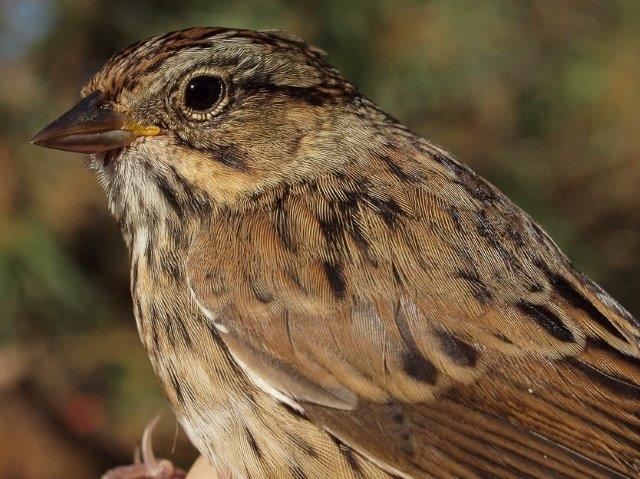
Our first Lincoln’s Sparrow of the season reflects a transition to the middle phase of fall migration (Photo by Simon Duval)
American Woodcock, Warbling Vireo (long overdue!), Blackpoll Warbler, and Lincoln’s Sparrow were all banded for the first time this fall. No species were newly observed for 2015, but the Lincoln’s Sparrow was a fresh addition for our fall 2015 list, as was Pine Siskin.
| # individuals banded | mean # individuals observed daily |
|---|---|
| 1. Swainson’s Thrush (25) [9] | 1. American Crow (31) [3] |
| 2. Magnolia Warbler (24) [3] | 2. Black-capped Chickadee (20) [5] |
| 3. Common Yellowthroat (17) [5] | 3. Common Grackle (17) [1] |
| 4. Red-eyed Vireo (12) [2] | 4. American Goldfinch (17) [2] |
| 5. Gray Catbird (11) [6] | 5. Canada Goose (14) [4] |
| 5. Northern Waterthrush (11) [-] | 6. Broad-winged Hawk (14) [-] |
| 7. Tennessee Warbler (9) [8] | 7. Blue Jay (14) [8] |
| 8. American Redstart (7) [3] | 8. Red-winged Blackbird (11) [-] |
| 8. White-throated Sparrow (7) [-] | 9. Common Yellowthroat (9) [-] |
| 10. Ovenbird (6) [-] 10. Nashville Warbler (6) [-] 10. Rose-breasted Grosbeak (6) [-] |
10. Gray Catbird (8) [9] |
Even though numbers were largely modest this week, there was quite a change in the composition of birds being banded. Whereas American Goldfinches dominated the past two weeks, only two individuals were banded this week. Instead, Swainson’s Thrush vaulted to the top of this week’s list, only the second time ever for the species (the other being week 7 in 2012, when an incredible 66 of them were banded). This brings the season total for Swainson’s Thrush to 59 – already higher than any previous full season total except fall 2012, and that year we had only banded 49 by this point. Magnolia Warbler was just behind, marking the tenth time in 11 years that it has been in the top two in week 6. However, the season total to date of 70 banded is lower than in any previous year except 2007 and 2009 (and in three other years we banded 70 or more in week 6 alone!). Common Yellowthroat, Red-eyed Vireo, and Gray Catbird round out the top five this week, all continuing in fairly good numbers. The catbirds in particular appear to have had another very strong year, as the total to date of 63 is slightly ahead of the 61 at this point last year, which ended up resulting in a season record of 94. On the other hand, Tennessee Warbler numbers remain unusually low, with the 32 banded to date this fall the fewest at this point in the season since 2009. American Redstart migration is distinctly tapering off now, but we now stand at 149 for the season, one short of the record set in 2011, with at least a few more certainly yet to come. Rounding out this week’s top ten were White-throated Sparrow, Ovenbird, Nashville Warbler, and Rose-breasted Grosbeak – with this week’s relatively late movement of migrants bringing the season total to 39, the highest since 2006.
The mix of dominant species observed in week 6 varies a fair bit from year to year, but American Crow was the top species in half of the previous ten years, and matched that again this year. The mean daily count of Black-capped Chickadees during week 6 has ranged from 18 to 26 over the years, and although closer to the low end of that range this year, the relatively modest numbers of other species were enough to leave chickadees in second place for the week. Last week’s top two species, Common Grackle and American Goldfinch, tapered off a bit to land in third and fourth place. Following them were three species separated by just percentage points – Canada Goose, Broad-winged Hawk, and Blue Jay. This is just the second time in 11 years that Broad-winged Hawk migration has been strong enough in week 6 to register among the top ten species for the week, but the goose and jay numbers were more typical (in fact, this marks the third straight year that Blue Jay is in seventh place with 14 individuals in week 6!). Although generally a common species at MBO, this is typically the low point of fall for Red-winged Blackbird, with a mean daily count for week 6 of 4.3 individuals over the past 10 years. While the mean daily count of 11 this week was still relatively modest, it was enough for Red-winged Blackbird to make its first ever appearance in the top ten at this time of year. The list rounded out with a lone warbler (Common Yellowthroat), and Gray Catbird just hanging on.
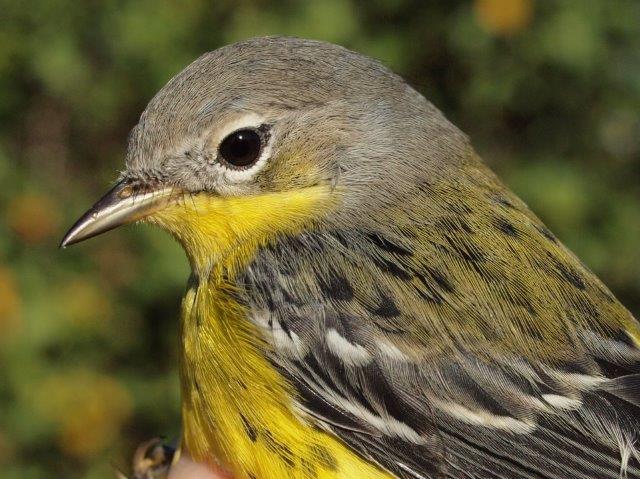 Although Magnolia Warblers are in smaller than usual numbers this fall, they remain one of the dominant species banded in early September (Photo by Simon Duval) |
Week 7 (September 12-18, 2015)
[
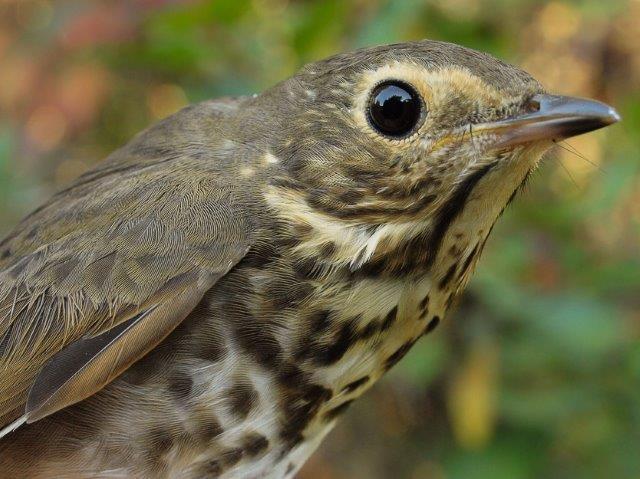 This is turning into another memorable fall migration for thrushes, most notably Swainson’s Thrush, with another 41 banded this week alone (Photo by Simon Duval) ] |
| THIS WEEK | THIS FALL | 2006 TOTAL | SITE TOTAL | |
|---|---|---|---|---|
| # birds (and species) banded | 297 (41) | 1505 (68) | 2991 (83) | 56198 (119) |
| # birds (and species) repeat | 49 (15) | 347 (35) | 655 (56) | 11356 (85) |
| # birds (and species) return | 4 (3) | 44 916) | 170 (32) | 1842 (51) |
| # species observed | 70 | 124 | 155 | 213 |
| # net hours | 452.8 | 3618.4 | 7108.7 | 109989.0 |
| # birds banded / 100 net hours | 68.2 | 41.6 | 42.0 | 50.9 |
Bander-in-charge: Simon Duval, Gay Gruner
Assistants: Christine Barrie, Gabriel Bergeon, Pascal Berthelot, Marc Boisvert, Cindy Bouchard, Alexander Boyer, Martha Bromby, David Davey, Stéfany Desroches, Marcel Gahbauer, Shannon Gailbraith, Nicole Guido, Alison Hackney, Lisa Keelty, Marcel Lebeau, Catherine Legault, Barbara MacDuff, Betsy McFarlane, Phillip Mercier, Anita Morales, Clémence Soulard, Patricia Stotland, Elise Titman, Rodger Titman, Christiane Tremblay, François Villeneuve
Notes: This was a week of two extremes in terms of weather, with cold rain on Saturday and Sunday that impeded banding, some warmer rain on Monday, and then four hot and sunny days with high temperatures up to 10 degrees Celsius above normal (with nightly lows often close to usual high temperatures! Accompanying the warm weather were persistent (although generally slight) south winds – just the opposite of what we would normally expect to bring migrants into MBO in fall. Despite that, we banded considerably more birds this week (297) than in any previous week this fall – reflecting the degree to which migration marches along to some extent regardless of weather! However, that number remains fairly modest compared to recent years, and the season total to date is the lowest since 2009. The effects of weather were perhaps more evident in the number of species observed, with many mid-season migrants not yet arriving – the 70 species observed over the past 7 days was fewer than in any previous week 7.
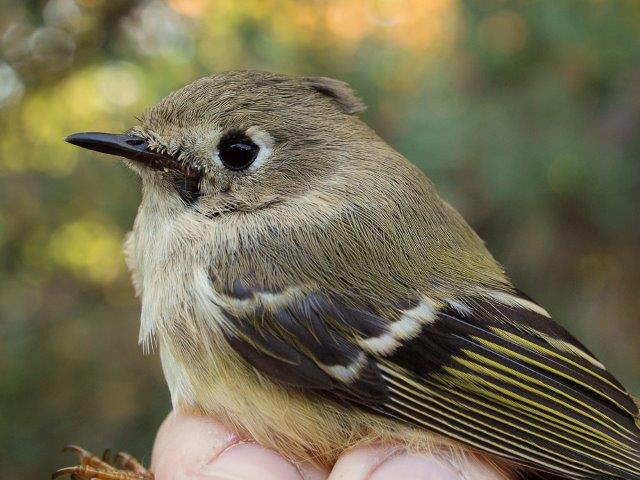
A reliable sign of transitioning to the middle period of fall migration is the arrival of groups of Ruby-crowned Kinglets (Photo by Simon Duval)
Four mid-season migrants were banded for the first time this fall (Brown Creeper, Ruby-crowned Kinglet, Gray-cheeked Thrush, and Western Palm Warbler), while we also got our overdue Philadelphia Vireo. Meanwhile, we added two species to our list of birds observed this year (Greater Yellowlegs and Northern Mockingbird), and five more for this fall (Golden-crowned Kinglet, Gray-cheeked Thrush, American Pipit, Western Palm Warbler, and Rusty Blackbird). September 15 was particularly productive, with three of the five species banded, and four of the seven species observed. September 18 was also notable, with the mockingbird (only the sixth in MBO’s history) being observed concurrently with multiple Brown Thrashers and Gray Catbirds, and chasing our first Rusty Blackbird of the fall from branch to branch.
| # individuals banded | mean # individuals observed daily |
|---|---|
| 1. Magnolia Warbler (60) [2] | 1. American Crow (21) [1] |
| 2. Swainson’s Thrush (41) [1] | 2. American Goldfinch (17) [4] |
| 3. Tennessee Warbler (24) [7] | 3. White-throated Sparrow (17) [-] |
| 4. Red-eyed Vireo (17) [4] | 4. Magnolia Warbler (17) [-] |
| 5. White-throated Sparrow (13) [8] | 5. Blue Jay (16) [7] |
| 6. Ovenbird (12) [10] | 6. Black-capped Chickadee (14) [2] |
| 7. Common Yellowthroat (11) [3] | 7. Broad-winged Hawk (14) [6] |
| 8. American Redstart (8) [8] | 8. Canada Goose (12) [5] |
| 9. Ruby-crowned Kinglet (7) [-] | 9. Swainson’s Thrush (11) [-] |
| 9. Gray Catbird (7) [5] 9. Nashville Warbler (7) [10] 9. Western Palm Warbler (7) [-] 9. Song Sparrow (7) [-] |
10. Cedar Waxwing (11) [-] |
Magnolia Warbler was the top species banded this week, with nearly 50% more than the runner-up, Swainson’s Thrush, in a reversal of last week’s top two. This is the fifth time in the past six years that Magnolia Warbler was the top species in week 7, and the 60 individuals banded is well above the ten-year mean of 44 for week 7. However, the season total to date of 134 remains unusually low; perhaps migration is simply late this year due to the persistent warm weather, and more are on their way next week. The number of Swainson’s Thrushes banded this week was more than in any previous full fall season except 2012 and 2014, although not as many as in week 7 of 2012 when we banded a single-week record of 66; this year’s season total to date is exactly 100. Week 7 is past the usual peak of fall migration for Tennessee Warbler, but this was the most productive week of the season so far, and the second highest week 7 total for the species in 11 years of monitoring. Red-eyed Vireo numbers remained strong for a third consecutive week, while White-throated Sparrows are starting to build in advance of their traditional late September to early October peak. With another dozen Ovenbirds banded this week, it is one of three species already setting a new fall season record this year, with a total of 58; the others are Brown Thrasher (12) and Veery (34). Common Yellowthroat and American Redstart numbers are starting to taper off more, but still going strong for the date. Among the five species tied for ninth place this week were two mid-season species starting to arrive (Ruby-crowned Kinglet and Western Palm Warbler), two local/migrant species continuing in modest numbers (Gray Catbird and Song Sparrow), and Nashville Warbler.
Although migration has been inhibited to some extent by the ongoing above-seasonal temperatures and south winds, we nonetheless saw a fair amount of turnover this week among the top ten species observed, with four new species entering the list, displacing Gray Catbird, Common Yellowthroat, Red-winged Blackbird, and Common Grackle. American Crow remained the top species for a second straight week, despite tying the record low daily mean count for week 7 set in 2009 and 2012. Similarly, American Goldfinch was the runner-up despite somewhat below average numbers compared to previous years. White-throated Sparrows have sometimes also been more numerous in week 7, but the past two years they were not even among the top ten; given that migration overall seems a bit late this fall, the numbers this week already may suggest a large movement ahead. Magnolia Warblers have been in below average numbers so far this fall, but for week 7, this year’s mean daily count is actually second to only the numbers observed in 2013. Blue Jay migration remained solid throughout the week, and we again had a good number of Broad-winged Hawks, including a lovely kettle of them wheeling in the sky on the last day of the week, mixed with Red-tailed and Red-shouldered Hawks as well as several Northern Harriers for comparison. Swainson’s Thrushes seemed to be everywhere this week, as reflected in the banding counts too; this was only the second time in 11 years that they have cracked the top ten for observations. Cedar Waxwings were irregular this week, as they have been for much of the season, but there were enough on some days to squeak into the top ten for the week.
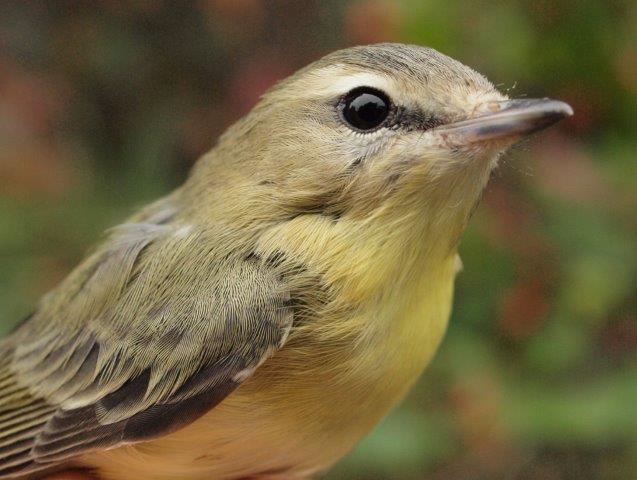
Generally the least common of the four vireo species at MBO, Philadelphia Vireos have been particularly scarce this fall, so it was encouraging to finally band four of the this week (Photo by Simon Duval)
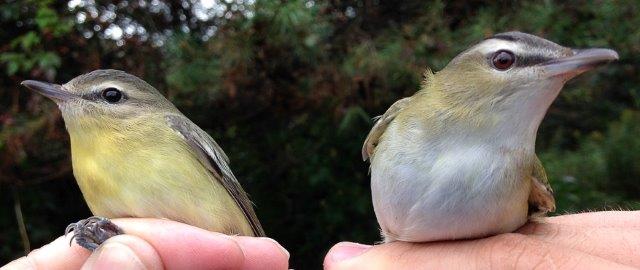
Banding provides a welcome opportunity to compare species side-by-side, int his case Philadelphia Vireo on the left and Red-eyed Vireo on the right (Photo by Gay Gruner)
Week 8 (September 19-25, 2015)
[
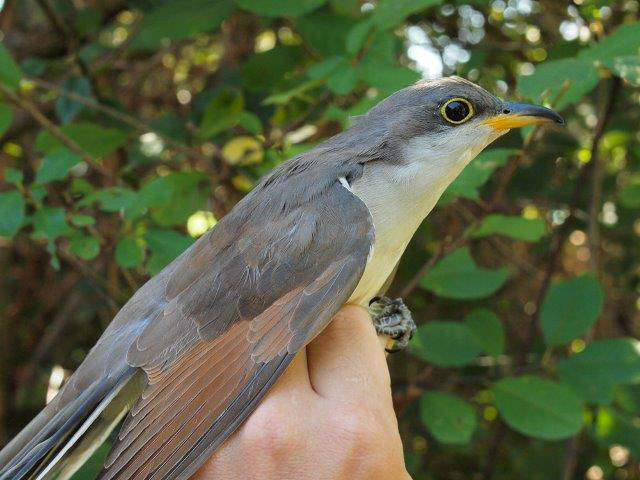 The first Yellow-billed Cuckoo banded at MBO in nearly ten years, and just the second overall, this was unquestionably the banding highlight of the week, and probably of this season (Photo by Simon Duval) ] |
| THIS WEEK | THIS FALL | 2006 TOTAL | SITE TOTAL | |
|---|---|---|---|---|
| # birds (and species) banded | 307 (41) | 1812 (72) | 3298 (84) | 56505 (119) |
| # birds (and species) repeat | 67 (17) | 414 (36) | 722 (56) | 11423 (85) |
| # birds (and species) return | 3 (2) | 47 (16) | 173 (32) | 1845 (51) |
| # species observed | 78 | 127 | 155 | 213 |
| # net hours | 560.0 | 4178 | 47668.7 | 110549.0 |
| # birds banded / 100 net hours | 54.8 | 43.4 | 42.9 | 51.0 |
Bander-in-charge: Simon Duval, Gay Gruner
Assistants: Michel Beaupré, Nicolas Bernier, Pascal Berthelot, Marc Boisvert, Zoe Bonerbo, Manon Bourdon, Alexander Boyer, Martha Bromby, Mathieu Charette, Claude Cloutier, David Davey, Jean Demers, Kyle Elliott, Marcel Gahbauer, Nicole Guido, Mélanie Guigueno, Alison Hackney, Diane Hamill, Lisa Keelty, Tom Kingsbury, Marcel Lebeau, Barbara MacDuff, Francine Marcoux, Betsy McFarlane, Phillip Mercier, Laura Molina, Benoît Piquette, Clémence Soulard, Patricia Stotland, Rodger Titman, Christiane Tremblay, Jesse White
Notes: Although we are into the second half of this year’s Fall Migration Monitoring Program, it was only this week that the calendar officially turned over to fall. However, with the largely continuing mild weather, especially at night, there remains only the slightest hint of fall colours on most of the trees at MBO. Despite this, there was a noticeable shift this week in birds observed and banded, reflecting the advancing season. The number of birds banded daily slowed down to 23-30 on the four warmest days in the middle of the week, but there were higher volumes at the beginning and end of week 8, resulting in a total of 307 that is marginally above average for the period, if the exceptional count of 1279 from 2010 is omitted from the calculation. As has been the case in recent weeks, the number of species observed was again somewhat below average despite good observer effort.

While Eastern Phoebe is a common species at MBO, this individual was unique, perching on chairs, approaching observers, and even taking buckthorn berries from the hand a couple of times! It hung around the observation area just outside the cabin for the final three days of the week (Photo by Marcel Gahbauer)
This week no species were observed for the first time in 2015, but White-crowned Sparrow, Slate-colored Junco, and Brown-headed Cowbird were new for this fall. The Yellow-billed Cuckoo was the first one banded in 2015, while we also banded our first Golden-crowned Kinglet, White-crowned Sparrow, and Slate-colored Junco of fall.
| # individuals banded | mean # individuals observed daily |
|---|---|
| 1. Swainson’s Thrush (56) [1] | 1. Canada Goose (260) [8] |
| 2. Magnolia Warbler (37) [2] | 2. Blue Jay (35) [5] |
| 3. White-throated Sparrow (25) [5] | 3. American Crow (34) [1] |
| 4. Golden-crowned Kinglet (18) [-] | 4. White-throated Sparrow (32) [3] |
| 5. Red-eyed Vireo (14) [4] | 5. American Robin (17) [-] |
| 6. Gray Catbird (13) [9] | 6. Black-capped Chickadee (16) [6] |
| 7. Song Sparrow (12) [9] | 7. American Goldfinch (16) [2] |
| 8. Blue Jay (11) [-] | 8. European Starling (14) [-] |
| 8. Tennessee Warbler (11) [3] | 9. Swainson’s Thrush (13) [9] |
| 10. Ruby-crowned Kinglet (10) [9] 10. Ovenbird (10) [6] |
10. Red-winged Blackbird (12) [-] |
For the third week in a row, Swainson’s Thrush and Magnolia Warbler were by far the two most commonly banded species, flip-flopping relative positions once again. The season total for Swainson’s Thrush is now up to 156, well ahead of the record pace set in 2012 when there had been 135 banded by the end of week 8, on the way to a season total of 176. In 2012, Swainson’s Thrush ranked third in week 8 behind White-throated Sparrow and Blue Jay; there were only 7 Magnolia Warblers banded that week. Despite the relatively good counts of Magnolia Warblers over the past three weeks, the season total is only 171, and is likely to end up as the lowest since 2009. White-throated Sparrow numbers this week were actually lower than expected, as it has been the top species for week 8 in six previous years, with an average of 52 banded. However, the two peak weeks for the species are immediately ahead, so we will soon have a better understanding of their numbers this fall. The biggest surprise this week came from the kinglets – Golden-crowned is typically a later migrant than Ruby-crowned, but outnumbered it this week for just the second time in week 8, and with a higher count than in any previous year. Red-eyed Vireos were banded in double digits for the fourth week in a row, Ovenbird extended its new fall season record, and another strong week for Gray Catbird hints at another new season record soon to come. On the other hand, both Tennessee Warbler and Song Sparrow numbers remain unusually low, and despite the surge in Blue Jays banded this week, their total is also below average so far.
One of the biggest changes this week was the arrival of large flocks of Canada Geese, which catapulted the species into the most observed bird of the week, by a giant margin. This is the 8th time in 11 years that Canada Goose has dominated week 8. Blue Jay moved up into second place, for just the second time in week 8, with somewhat above average numbers for the period, while American Crow was near a record low, yet still in the top three. As with numbers banded, the count of White-throated Sparrows observed was below average for the period. American Robin flocks are also starting to build as we approach late fall, although numbers are still on the low side; the same is true for European Starling and Red-winged Blackbird. The resident Black-capped Chickadees remained in stable numbers, while there were far fewer American Goldfinches than last week, although the count was typical for this point in fall. Swainson’s Thrush remained unusually numerous throughout most of the week, enough to reach the top ten for the first time ever in week 8.
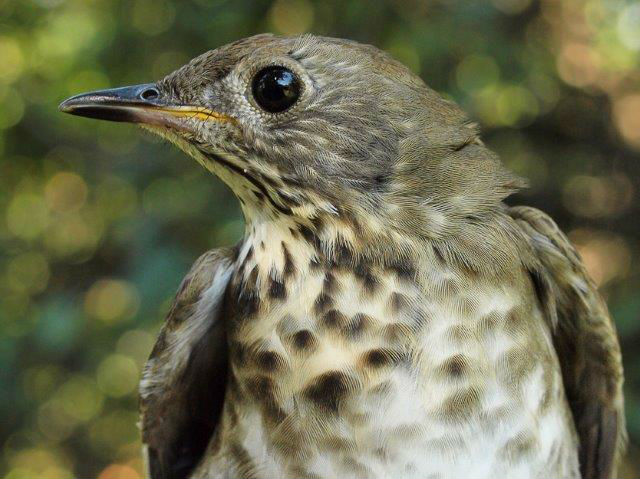
While Swainson’s Thrushes were dominating this week, Gray-cheeked Thrushes were also moving in higher than usual numbers, with 7 individuals banded this week alone (more than in seven entire fall seasons), including this one (Photo by Simon Duval)
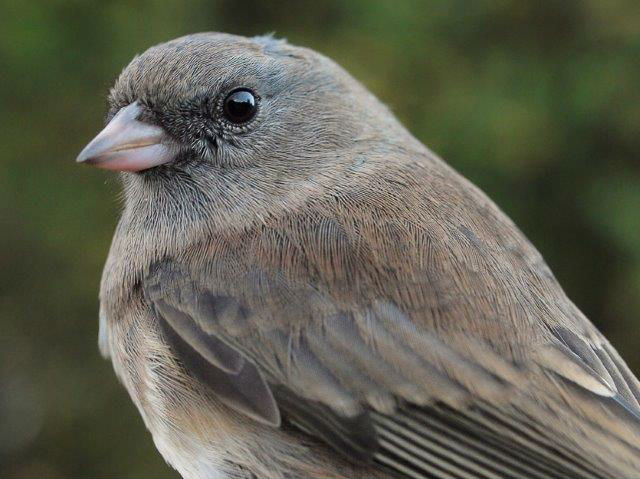
The arrival of Slate-colored Juncos this week was among the key signs of the advancing season, despite the continuing warm weather and green leaves (Photo by Simon Duval)
Week 9 (September 26 – October 2, 2015)
[
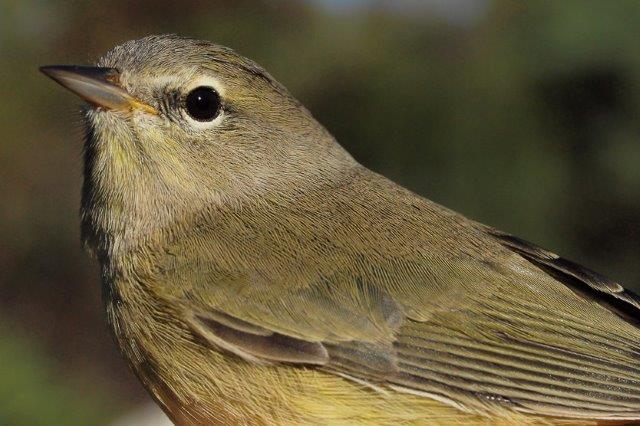 The arrival of the first Orange-crowned Warbler of fall on September 30 matched the record late date established in 2008; this individual (possibly the same bird) was banded the next morning (Photo by Simon Duval) ] |
| THIS WEEK | THIS FALL | 2006 TOTAL | SITE TOTAL | |
|---|---|---|---|---|
| # birds (and species) banded | 174 (34) | 1986 (75) | 3472 (86) | 56679 (119) |
| # birds (and species) repeat | 39 (11) | 453 (37) | 761 (57) | 11462 (85) |
| # birds (and species) return | 2 (2) | 49 917) | 175 (32) | 1847 (51) |
| # species observed | 77 | 131 | 156 | 213 |
| # net hours | 486.0 | 4664.4 | 8154.7 | 111035.0 |
| # birds banded / 100 net hours | 35.8 | 42.6 | 42.5 | 50.9 |
Bander-in-charge: Simon Duval, Gay Gruner.
Assistants: Angelika Aleksieva, Pascal Berthelot, Zoe Bonerbo, Alexander Boyer, Martha Bromby, Mathieu Charette, Luke Currin, David Davey, Jean Demers, Steve Dumont, Marcel Gahbauer, Shannon Gailbraith, Nicole Guido, Alison Hackney, Lisa Keelty, Marcel Lebeau, Barbara MacDuff, Asya Malinova, Francine Marcoux, Betsy McFarlane, Phillip Mercier, Emma Nip, Catherine Russell, Clémence Soulard, Patricia Stotland, Natalie Thimot, Elise Titman, Rodger Titman, Christiane Tremblay, François Villeneuve.
Notes: Week 9 at MBO this year was most unusual. Although a few of the trees on the forested slopes overlooking MBO are finally showing patches of yellow, the limited advance of fall colours is even more conspicuous than last week. Meanwhile, it almost seems as if the birds are waiting for that change to progress, as the count of birds banded this week (174) was a record low for the period, and by a long shot at that (the previous low was 263 in 2015, while the record high was 1112 in 2008 and the mean over the past decade was 530); windy conditions for much of the week no doubt had some effect on driving the capture rate to its lowest level ever for week 9. The 77 species observed this week is lower than has been the norm for week 9 over the past four years, but close to the long-term mean at this point in fall..
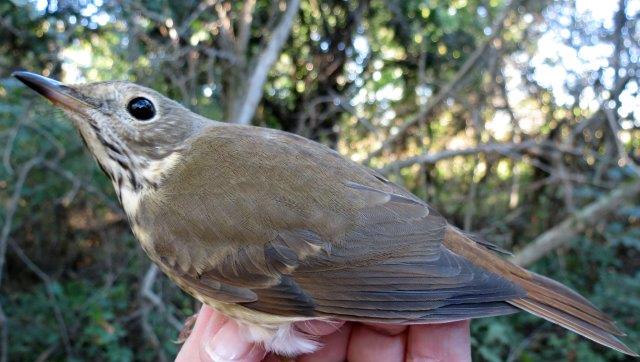
With near-record numbers of Swainson’s Thrushes migrating through MBO this fall, we are curious to see whether Hermit Thrushes will show a similar spike, now that their migration period is beginning (Photo by Simon Duval)
Three species banded this week were new for fall 2015 – Winter Wren, Hermit Thrush, and Orange-crowned Warbler; the wren and warbler were both new for the entire year in fact. As well, four species were observed for the first time this season – Cackling Goose, Hermit Thrush, Orange-crowned Warbler, and Fox Sparrow; only the goose was new for the year.
| # individuals banded | mean # individuals observed daily |
|---|---|
| 1. White-throated Sparrow (51) [3] | 1. Canada Goose (319) [1] |
| 2. Blue Jay (16) [8] | 2. Blue Jay (65) [2] |
| 3. Ruby-crowned Kinglet (14) [10] | 3. American Crow (47) [3] |
| 4. Slate-colored Junco (13) [-] | 4. White-throated Sparrow (46) [4] |
| 5. Yellow-rumped Warbler (10) [-] | 5. American Robin (33) [5] |
| 6. Swainson’s Thrush (9) [1] | 6. European Starling (22) [8] |
| 7. Gray Catbird (8) [6] | 7. Black-capped Chickadee (20) [6] |
| 8. Golden-crowned Kinglet (7) [4] | 8. Red-winged Blackbird (19) [10] |
| 9. Song Sparrow (5) [7] | 9. Yellow-rumped Warbler (17) [7] |
| 10. Black-throated Blue Warbler (4) [-] 10. Indigo Bunting (4) [-] |
9. American Goldfinch (17) [-] |
More than three times as many White-throated Sparrows were banded this week than any other species, and this marked the seventh time in 11 years that the species was the most banded in week 9. However, reflecting the overall low numbers this week, the 51 White-throated Sparrows banded is just barely ahead of the record low for week 9 (49 individuals in 2011). Conversely, the 16 Blue Jays banded was behind only last year’s record high count of 23 in week 9. The most notable result this week was the low number of Ruby-crowned Kinglets – fewer than one-third as many as the previous record of 45 set in 2007 and matched in 2009 and 2014. Similarly, the 10 Yellow-rumped Warblers banded this week was a record low for week 9. However, Slate-colored Juncos are appearing on schedule in typical numbers, and although the Swainson’s Thrush migration is finally nearing its end, the number banded this week remained well above average. Among the rest of the top ten, the most interesting results were the two “blue birds” tied for tenth place – Black-throated Blue Warbler and Indigo Bunting.
In a rare event, the top five species observed this week were all the same as last week, although for each of them the mean daily count increased compared to week 8. As in every previous year, Canada Goose was the most numerous species during week 9. The count of Blue Jays was well above average, matching the number observed in 2012, but below the high mean daily count of 94 in 2010. Our observations are consistent with reports of large counts of Blue Jays migrating through southern Ontario – more than 10,000 per day in some locations along Lake Erie! Most notable among the other species was Yellow-rumped Warbler, which remained among the top ten species observed this week even though relatively few were banded, reflecting that persistent winds through much of the week likely affected banding rates.
Last but not least, this week marked the start of our six-week owl banding season, with effort scheduled nightly (weather permitting). As expected, the early results were modest, with 5 Northern Saw-whet Owls banded, plus a recapture of an individual banded in South Hadley, Massachusetts in fall 2013, and now three years old.
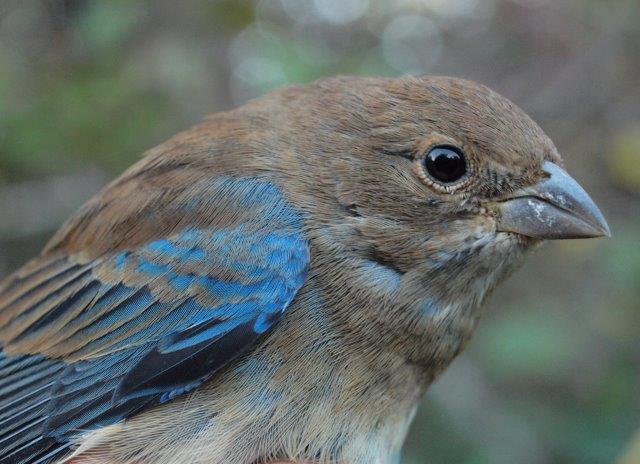
The number of Indigo Buntings observed and banded this week was above average, and included this nicely marked after-hatch-year male (Photo by Simon Duval)
Week 10 (October 3-9, 2015)
[
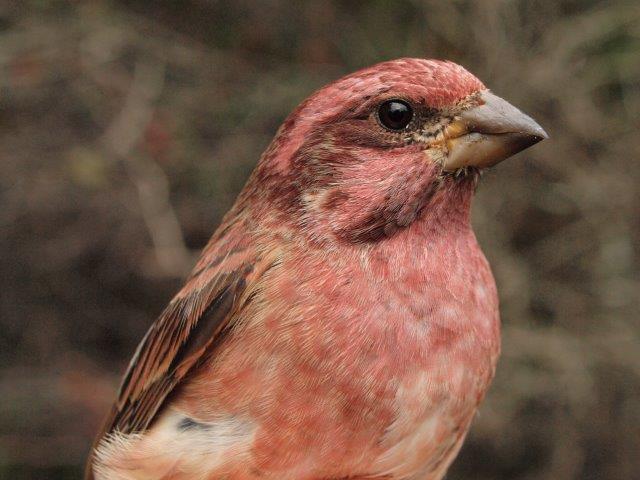 It was a great week at MBO for Purple Finches, with 8 individuals banded, the most for a single week since fall 2012 (Photo by Simon Duval) ] |
| THIS WEEK | THIS FALL | 2006 TOTAL | SITE TOTAL | |
|---|---|---|---|---|
| # birds (and species) banded | 352 (28) | 2338 (75) | 3824 (86) | 57013 (119) |
| # birds (and species) repeat | 80 (14) | 533 (43) | 841 (60) | 11542 (85) |
| # birds (and species) return | 2 (2) | 51 (19) | 177 (34) | 1849 (51) |
| # species observed | 74 | 137 | 159 | 213 |
| # net hours | 476.0 | 5140.4 | 8630.7 | 11511.0 |
| # birds banded / 100 net hours | 73.9 | 45.5 | 44.2 | 51.0 |
Bander-in-charge: Simon Duval, Gay Gruner.
Assistants: Pascal Berthelot, Marc Boisvert, Zoe Bonerbo, Manon Bourdon, Alexander Boyer, Martha Bromby, Luke Currin, David Davey, Jean Demers, Katelyn Depot, Stéfany Desroches, Steve Dumont, Shannon Gailbraith, Alison Hackney, Lisa Keelty, Lorenzo Kleine, Marcel Lebeau, Barbara MacDuff, Francine Marcoux, Betsy McFarlane, Phillip Mercier, Anita Morales, Clémence Soulard, Rodger Titman, Christiane Tremblay, Jesse White.
Notes: After a record-quiet week 9, we were pleased to see migration pick up somewhat this week. Granted, the 352 birds banded is still somewhat below average for the period, it was more than twice as many as last week, and actually better than last year at the same time. The season total to date, however, remains the lowest since 2007, and it seems unlikely at this point that the pace of migration is going to change significantly over the final few weeks of fall. In terms of observations it was a somewhat above average week, with 74 species observed, bringing the season total to 137, a bit above the long-term average for week 10..
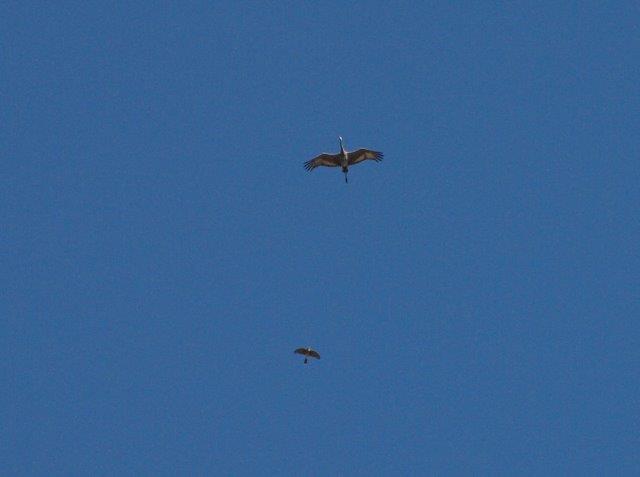
The highlight of the week was this Sandhill Crane flying over MBO, seemingly being escorted by a Cooper’s Hawk. It was only the fourth Sandhill Crane observed at MBO in 11 years, although the second sighting for 2015 (Photo by Simon Duval)
Although the fall banding list received no new additions this week, it was a productive period for observations, with three species new for the year (Herring and Great Black-backed Gulls, plus Northern Saw-whet Owl), and three more for this fall (Sandhill Crane, Eastern Bluebird, and Field Sparrow). We also added two species to our list of returns for 2015 – White-breasted Nuthatch and Nashville Warbler.
| # individuals banded | mean # individuals observed daily |
|---|---|
| 1. Ruby-crowned Kinglet (116) [3] | 1. Canada Goose (476) [1] |
| 2. White-throated Sparrow (88) [1 | 2. European Starling (317) [6] |
| 3. Yellow-rumped Warbler (24) [5] | 3. Common Grackle (187) [-] |
| 4. Slate-colored Junco (23) [4] | 4. American Robin (89) [5] |
| 5. Song Sparrow (21) [9] | 5. Red-winged Blackbird (82) [8] |
| 6. American Robin (15) [-] | 6. White-throated Sparrow (68) [4] |
| 7. Golden-crowned Kinglet (10) [8] | 7. Ruby-crowned Kinglet (45) [-] |
| 8. Purple Finch (8) [-] | 8. American Crow (45) [3] |
| 9. Swainson’s Thrush (6) [6 | 9. Blue Jay (30) [2] |
| 9. White-crowned Sparrow (6) [-] | 10. Yellow-rumped Warbler (26) [9] |
As the table above clearly indicates, this week’s banding totals were largely driven by two species. Week 10 is the traditional peak of migration for both Ruby-crowned Kinglet and White-throated Sparrow, and both showed up in close to average numbers this year. The 116 kinglets banded was just one more than the average of 115 during week 10 over the previous ten years, while the sparrows were 10% above the long-term average of 80 banded in week 10. The next tier of abundance this week was shared by Yellow-rumped Warbler, Slate-colored Junco, and Song Sparrow, all also commonly among the top ten in week 10 (11 years straight in the top five for the warbler, 11 in the top ten for the sparrow, and 10 in the top ten for the junco). American Robin is only sometimes in the top ten this early in October, so perhaps this is an omen of oncoming numbers. Despite a strong start to the season, Golden-crowned Kinglet numbers are now somewhat lower than normal. On the other hand, the 8 Purple Finches banded this week is the fourth highest weekly total in MBO’s history (the three higher counts were all in fall 2012). This year’s remarkably strong Swainson’s Thrush migration is tapering off further, but another 6 were banded this year, bringing the season total to 171 (just a bit short of the record of 176 in 2012, but already more than quadruple the long-term fall mean total of 38). Although White-crowned Sparrow squeaked into the top ten, the count this week was less than half the long-term mean of 16 for week 10, and overall the species has seemed unusually scarce so far this fall.
Canada Goose numbers increased further this week, remaining the most abundant bird observed this week (as has been the case in week 10 every year except for 2012). Aside from them, black birds featured prominently, with European Starling, Common Grackle, and Red-winged Blackbird all among this week’s top five, and American Crow farther down the top ten. Most years one of the three smaller species is among the top five; only three times previously were two of them that abundant in the same year, and this marks the first time all three of them were that numerous at the same time. American Robin numbers are always building by this point in October, and the mean daily count this week of 89 was just a bit below average, with the range over the past ten years for week 10 being 62 to 154. The count of White-throated Sparrows this week was also very close to typical (68, compared to a ten-year mean of 71 per day during week 10), as was the case for Ruby-crowned Kinglet (45 vs. 44). Blue Jay migration remains strong, and we had a decent movement of Yellow-rumped Warblers, although certainly nothing like in some past years.
As for owling, it was a productive week, with 47 Northern Saw-whet Owls banded, well above the mean of 33 for this period over the past six years. The first night of the week was the only one without any captures; on all other nights at least three owls were banded, with a high of 19 on the night of October 7. Surprisingly given the number of owls banded this week there were no foreign recaptures, but we expect that with the peak of the season yet to come, there will be others to report soon.
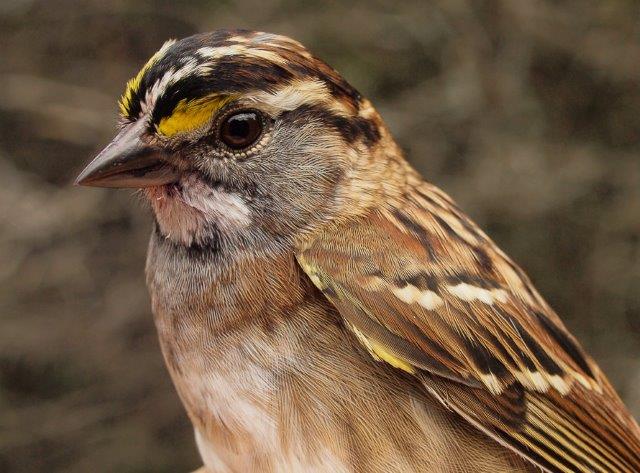
As with a number of other northern species, we are seeing a higher than usual proportion of adult White-throated Sparrows this fall, suggesting that breeding success was lower than normal (Photo by Simon Duval)
Week 11 (October 10-16, 2015)
[
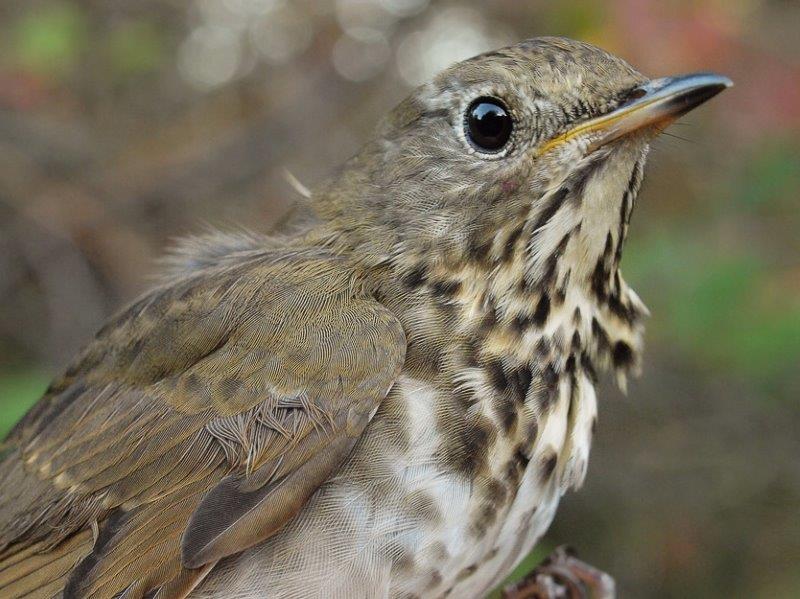 The banding highlight of the week was this Bicknell’s Thrush, only the sixth one ever banded at MBO (Photo by Simon Duval) ] |
| THIS WEEK | THIS FALL | 2006 TOTAL | SITE TOTAL | |
|---|---|---|---|---|
| # birds (and species) banded | 300 (25) | 2638 (76) | 4124 (87) | 57331 (119) |
| # birds (and species) repeat | 67 (11) | 600 (44) | 908 (61) | 11609 (86) |
| # birds (and species) return | 2 (2) | 53 (20) | 179 (34) | 1851 (51) |
| # species observed | 74 | 141 | 162 | 213 |
| # net hours | 493.5 | 5633.9 | 9124.2 | 112004.5 |
| # birds banded / 100 net hours | 60.8 | 46.8 | 45.1 | 51.0 |
Banders-in-charge: Simon Duval, Marcel Gahbauer
Assistants: Nicolas Bernier, Pascal Berthelot, Zoe Bonerbo, Manon Bourdon, Martha Bromby, Luke Currin, David Davey, Stéfany Desroches, Dominique Dufault, Kyle Elliott, Shannon Gailbraith, Nicole Guido, Mélanie Guigueno, Alison Hackney, Lisa Keelty, Lorenzo Kleine, Marcel Lebeau, Barbara MacDuff, Don MacDuff, Asya Malinova, Francine Marcoux, Betsy McFarlane, Phillip Mercier, Laura Molina, Catherine Russell, Clémence Soulard, Patricia Stotland, Rodger Titman, Christiane Tremblay, François Villeneuve, Jesse White
Notes: Migration this week continued at a similar pace to week 10 – in other words, numbers were a bit above average for this fall, but somewhat lower than long-term means for the period. The 2638 birds banded so far this season is more than at this point in 2007 or 2011, but lower than all other years. It is perhaps too early to draw conclusions, but intriguing to note that a four-year pattern is starting to appear with respect to these fall lows. Again though, diversity remained above average, with the 74 species observed this week just one below the record set for week 11 last year, and 141 species for the season only two short of the record pace of 143 at this point both last year and in 2013. Temperatures were again above normal for much of this week, most notably with a record high of 25 Celsius on Thanksgiving day.
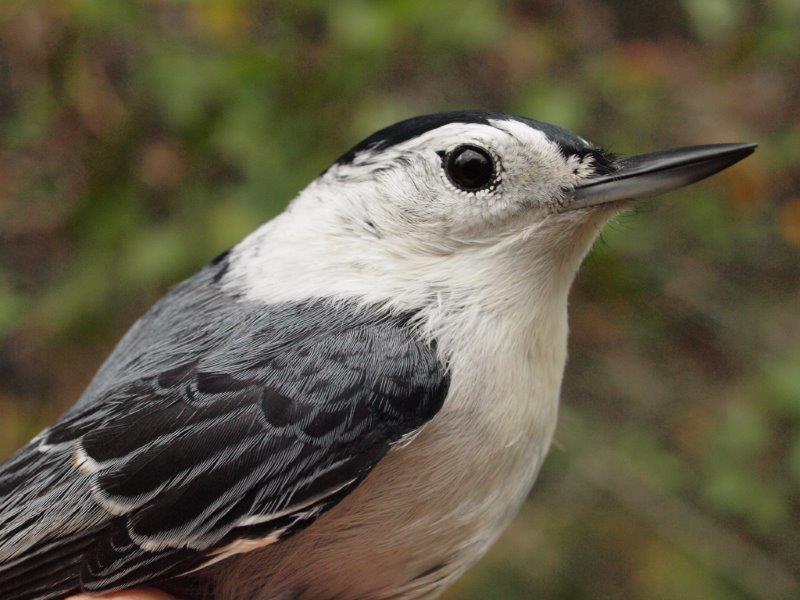
lthough a year-round resident at MBO, White-breasted Nuthatches are only occasionally banded; this week was only the second time in MBO’s history that two were banded in a single week (Photo by Simon Duval)
It was a good week at MBO for uncommon to rare birds. The Bicknell’s Thrush banded this week was our first of 2015, and in fact the first observation of this species at MBO since the first week of October 2012. We recaptured it a couple of days later, marking the first ever repeat of this species at MBO. We also observed and banded our first Yellow Palm Warbler of the year this week, and observed Eastern Screech-Owl during the daytime operations of the Fall Migration Monitoring Program for just the fifth time in 11 years. The Evening Grosbeak observation this week was the first in nearly two years. But as noteworthy as all of those was the Blue Jay that we recaptured on Thanksgiving morning – and upon checking our database realized it had been banded more than 11 years earlier! In fact, it was among the first 100 birds banded at MBO during our pilot season in September 2004; it was recaptured again that November, but not recorded since, so this was a remarkable rediscovery.
| # individuals banded | mean # individuals observed daily |
|---|---|
| 1. White-throated Sparrow (88) [2] | 1. Canada Goose (195) [1] |
| 2. Ruby-crowned Kinglet (85) [1] | 2. American Robin (143) [4] |
| 3. Yellow-rumped Warbler (18) [3] | 3. Common Grackle (121) [3] |
| 4. American Robin (16) [6] | 4. Red-winged Blackbird (108) [5] |
| 5. Slate-colored Junco (12) [4] | 5. White-throated Sparrow (70) [6] |
| 5. American Goldfinch (12) [-] | 6. American Crow (60) [8] |
| 7. Hermit Thrush (11) [-] | 7. European Starling (53) [2] |
| 8. Golden-crowned Kinglet (8) [7 | 8. Ruby-crowned Kinglet (36) [7] |
| 8. Purple Finch (8) [8] | 9. Blue Jay (26) [9] |
| 10. Black-capped Chickadee (5) [-] 10. Orange-crowned Warbler (5) [-] 10. Song Sparrow (5) [5] |
10. Black-capped Chickadee (17) [-] |
White-throated Sparrow and Ruby-crowned Kinglet swapped positions this week at the top of the list of birds banded, but both were far more abundant than any other species. This is the second year in a row that White-throated Sparrow has topped the week 11 list; the previous three years it ranked second, and prior to that it was never higher than fifth! Ruby-crowned Kinglet has been more consistent over time, among the top three in week 11 every year except 2008 (fourth) and 2010 (seventh). Despite good counts over the past two weeks, both species are still below average for the season. Yellow-rumped Warbler migration is nearing its end, but there were enough this week to crack the top three even though the season total to date of 57 suggests this will be the poorest fall migration for the species at MBO. Continuing the theme, American Robin was in fourth place this week, bringing the season total to 47 banded, well below the long-term average of 85 by this point in the season. Junco numbers slipped slightly from last week, but we suspect more are yet to come. American Goldfinches have been erratic this fall; this marks the first time ever they have been in the top ten during week 11. This is the traditional peak of Hermit Thrush migration, but the 11 banded this week was the third-lowest total ever for this week, and the season total to date is less than half the long-term mean. Golden-crowned Kinglets were again far scarcer than Ruby-crowned, heading toward the lowest fall banding total since 2009; tied with them in eighth place was Purple Finch, with a surprisingly strong showing for a second week in a row. Rounding out the top ten was an eclectic three-way tie, with two common late season species (Black-capped Chickadee and Song Sparrow), and one that has only been in the top ten for the week once previously (Orange-crowned Warbler, in 2006); this was only the third time ever that 5 or more Orange-crowned Warblers were banded in a single week at MBO.
Among species observed, results were relatively similar to last week, with nine of the same species dominating, while Black-capped Chickadee replaced Yellow-rumped Warbler in tenth place. Canada Goose numbers declined by more than half compared to week 10, but were still high enough to take first place in week 11 for the third year in a row, and sixth out of 11. In four of the other years, the top bird has been American Robin, which was second this week, with numbers building in advance of the traditional late October peak. Mixed blackbird flocks remained common this week, with Red-winged Blackbird and Common Grackle both in the top four, sometimes joined by European Starlings. White-throated Sparrows were present in almost the same numbers as last week, but shifted up one place in the rankings; conversely Ruby-crowned Kinglet numbers tapered off slightly and they dropped one spot. Remarkably, Blue Jay numbers remained high for yet another week.
On the owling front, it was another productive week, with another 55 Northern Saw-whet Owls banded. The biggest movement was on the night of October 14, with 24 individuals – the busiest night of the season so far, and the fourth highest single-night total in MBO’s history (behind 25 on October 5, 2011, and 30 on both October 22, 2011 and October 16, 2012). The season total to date is up to 107, second to only the record high season in 2012. There was one more foreign recapture this week, banded in early October 2014 at Innis Point Bird Observatory in Ottawa, roughly 200 km west along the Ottawa River.
Week 12 (October 17-23, 2015)
| THIS WEEK | THIS FALL | 2006 TOTAL | SITE TOTAL | |
|---|---|---|---|---|
| # birds (and species) banded | 159 (20) | 2797 (80) | 4283 (89) | 57490 (119) |
| # birds (and species) repeat | 49 (10) | 649 (46) | 957 (61) | 11658 (86) |
| # birds (and species) return | 1 (1) | 54 (20) | 180 (34) | 1852 (51) |
| # species observed | 66 | 145 | 163 | 213 |
| # net hours | 455.0 | 6088.9 | 9579.2 | 112459.5 |
| # birds banded / 100 net hours | 34.9 | 45.9 | 44.6 | 51.0 |
Banders-in-charge: Simon Duval, Gay Gruner
Assistants: Nicolas Bernier, Pascal Berthelot, Marc Boisvert, Martha Bromby, Luc Coupal, Luke Currin, David Davey, Jean Demers, Katelyn Depot, Kyle Elliott, Shannon Gailbraith, Mélanie Guigueno, Alison Hackney, Lisa Keelty, Lorenzo Kleine, Helen Kohler, Marcel Lebeau, Barbara MacDuff, Asya Malinova, Betsy McFarlane, Phillip Mercier, Emma Nip, Catherine Russell, Clémence Soulard, Patricia Stotland, Rodger Titman, Christiane Tremblay, François Villeneuve
Notes: Befitting an unusually quiet fall migration, results for week 12 were close to record lows. The total of 159 birds banded this week was only slightly more than the record low of 139 for the period in 2011, and the season total of 2797 is not far ahead of the low of 2646 at the same point in 2011; unless numbers pick up in week 13, this will mark just the third time in 11 years that the season total falls short of 3000 individuals banded. On the other hand, diversity has been particularly high this fall, as this is just the second time the 80-species threshold has been reached for the season. Similarly, the 66 species observed this week was a new record high for week 12, although the count of 145 for the season is a bit behind the high of 148 at this point in the season in 2005. Weather was largely more seasonal this week, and one day was lost to rain, although effort on the whole was still above average for week 12.
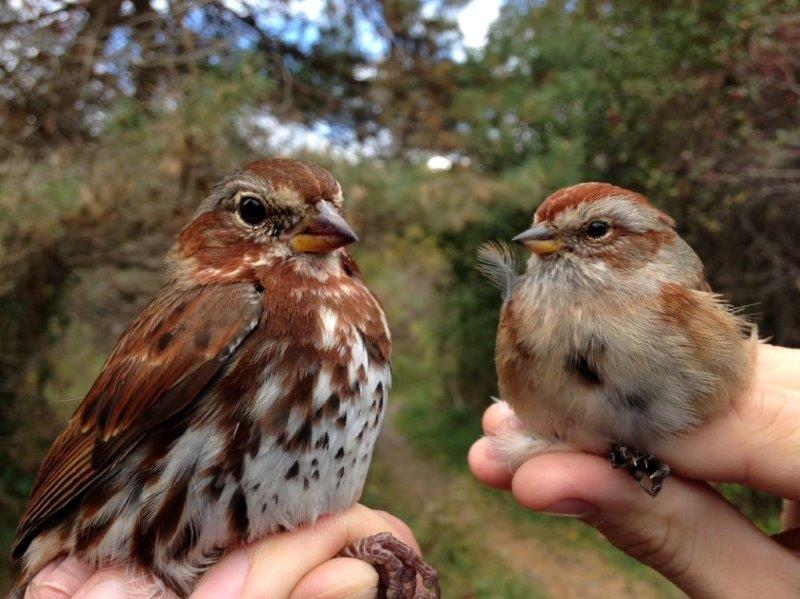
Both of these sparrows were banded this week for the first time this fall; this comparison shows just how much bigger Fox Sparrows are than American Tree Sparrows (Photo by Simon Duval)
One of the inherent contradictions about late fall is that while migration is slowing down overall, we usually get an influx of “new” species for the season. That held true this week both for species observed and banded. The first Horned Lark of 2015 was seen this week, while Red-bellied Woodpecker, Bohemian Waxwing, and American Tree Sparrow were new for fall. It was the latest ever fall arrival date for American Tree Sparrow, while Bohemian Waxwing has not been observed in fall since 2012. For the third time in five years, a Northern Saw-whet Owl was banded as part of the morning banding activities, presumably a bird that came in during the night but was not captured during the owl banding efforts. Mourning Dove was also banded for the first time in 2015, while American Tree Sparrow and Fox Sparrow were banded for the first time this fall.
| # individuals banded | mean # individuals observed daily |
|---|---|
| 1. American Robin (47) [4] | 1. American Robin (241) [2] |
| 2. White-throated Sparrow (23) [1] | 2. Red-winged Blackbird (134) [4] |
| 3. Ruby-crowned Kinglet (17) [2] | 3. Canada Goose (68) [1] |
| 4. Golden-crowned Kinglet (12) [8] | 4. Common Grackle (52) [3] |
| 5. Hermit Thrush (11) [7] | 5. European Starling (49) [7] |
| 6. American Tree Sparrow (9) [-] | 6. White-throated Sparrow (39) [5] |
| 7. Song Sparrow (8) [10] | 7. American Crow (34) [6] |
| 8. Slate-colored Junco (6) [5] | 8. Blue Jay (23) [9] |
| 9. Swamp Sparrow (4) [-] | 9. Slate-colored Junco (19) [-] |
| 9. Fox Sparrow (4) [-] | 10. Black-capped Chickadee (14) [10] |
American Robin was the top species banded in week 12, for the sixth time in 11 years, even though the number banded was well below the mean of 80 for this period. Ruby-crowned Kinglets were also close to half as numerous as usual (ten-year mean of 33 banded in week 12), but White-throated Sparrows and Golden-crowned Kinglets were marginally above average. We banded 11 Hermit Thrushes for a second week in a row, but the season total remains lower than normal. In an unusual occurrence, the bottom half of the ten comprises nothing but sparrows. Reflecting the overall low numbers this week, all of them except Swamp Sparrow were banded in below average quantities, most notably Slate-colored Junco (ten-year mean of 55 individuals in week 12).
What happened to the geese? That was one of the most notable changes among birds observed this week, with Canada Goose falling out of the top spot, and the mean daily count of 68 lower than ever before for week 12. Instead, American Robin took over as the dominant species, topping the list in week 12 for the fourth time in 11 years. Red-winged Blackbird was the runner-up, and has now been in the top three at this time of year for ten years in a row. Rounding out the top five were Common Grackle and European Starling, both common in late fall. White-throated Sparrow numbers declined compared to last week, but remained higher than in any previous week 12 except for 2014. Among the corvids there are opposing records – the mean daily count of American Crow was far below the previous low of 53 in 2013, while the mean daily count of Blue Jay was above the previous high of 18 in 2011. The mean daily count of Slate-colored Juncos has surprisingly high, considering how few were banded this week; Black-capped Chickadee completed the top ten with somewhat below normal numbers.
In more positive news, it was a remarkable week for the owl banding program, with 107 Northern Saw-whet Owls banded – shattering the previous single-week record of 75 (October 3-9, 2011). This week’s tally perfectly doubled the season total; the 214 individuals banded to date is one ahead of the record pace in 2012. No doubt this marks the highest ratio ever of owls to songbirds banded in a single week! In addition, one foreign-banded owl was captured this week, but no details are available yet as to where it was banded.
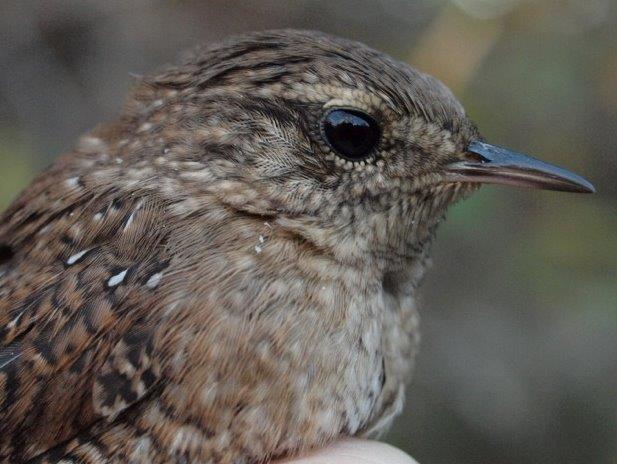
Like many boreal species, Winter Wrens have been scarcer than usual this fall; this was one of three banded this week, among a season total to just five (Photo by Simon Duval)
Week 13 (October 24-30, 2015)
| THIS WEEK | THIS FALL | 2006 TOTAL | SITE TOTAL | |
|---|---|---|---|---|
| # birds (and species) banded | 208 (24) | 3005 (83) | 4491 (90) | 57698 (119) |
| # birds (and species) repeat | 36 (10) | 688 (47) | 996 (61) | 11697 (86) |
| # birds (and species) return | 3 (3) | 57 (21) | 183 (34) | 1855 (51) |
| # species observed | 62 | 149 | 164 | 213 |
| # net hours | 526.2 | 6615.1 | 10105.4 | 112905.7 |
| # birds banded / 100 net hours | 39.5 | 45.4 | 44.4 | 50.9 |
Banders-in-charge: Simon Duval, Gay Gruner
Assistants: Michel Beaupré, Nicolas Bernier, Pascal Berthelot, Marc Boisvert, Manon Bourdon, Alexander Boyer, Martha Bromby, Luke Currin, David Davey, Dominique Dufault, Alison Hackney, Lisa Keelty, Lorenzo Kleine, Marcel Lebeau, Barbara MacDuff, Asya Malinova, Francine Marcoux, Betsy McFarlane, Phillip Mercier, Emma Nip, Catherine Russell, Paule Schetagne, Clémence Soulard, Elise Titman, Rodger Titman, Christiane Tremblay, François Villeneuve
Notes: Week 13 has traditionally been the end of our Fall Migration Monitoring Program, going back to our first full season in 2005. However, in recent years it has become apparent that the tail end of migration for some of our priority species (e.g., American Tree Sparrow, Slate-colored Junco, Fox Sparrow) is increasingly often carrying over into early November, and as such, stopping on October 30 leaves us with an incomplete picture of their numbers. Because of that, we tested out an “informal” extra week last fall, and this year will be including week 14 as an official part of the season. All the same, the totals as of this week are of particular interest with respect to comparing results with previous seasons.
As has been the case for much of this fall, the number of birds banded this week was a bit below average, but in this case just enough to lift our total past the 3000-bird threshold. Even so, it is the third-lowest season total, ahead of only 2011 (2792) and 2007 (2877) – and when considering birds banded per 100 net hours, this fall (45.4) is only marginally ahead of the low point of 43.7 in 2011. On the other hand, the number of species banded in fall has tended to be quite consistent (between 74 and 78 in nine of ten previous years), so the 83 this season (second only to 86 in 2012) was a pleasant surprise. Similarly, the number of species observed for the season (149) is above average, as were the 62 species this week. Once the season wraps up after week 14, we will review our data in greater detail as part of the preparation of our annual report on MBO activities.
As noted last week, late fall still brings us a number of “new” birds. This week we banded Northern Shrike (the first for 2015), European Starling, and Red-winged Blackbird for the first time this fall – the latter two species coming on the final day! The shrike was also observed for the first time this fall, as were Snow Goose, Common Merganser, and Rough-legged Hawk. The hawk also waited until the very last morning to show up, and was our first for 2015 overall.
| # individuals banded | mean # individuals observed daily |
|---|---|
| 1. American Robin (117) [1] | 1. American Robin (630) [1] |
| 2. American Tree Sparrow (20) [6] | 2. European Starling (281) [5] |
| 3. White-throated Sparrow (15) [2] | 3. Red-winged Blackbird (185) [2] |
| 4. Ruby-crowned Kinglet (6) [3] | 4. Canada Goose (155) [3] |
| 4. Northern Cardinal (6) [-] | 5. Common Grackle (99) [4] |
| 4. Slate-colored Junco (6) [8] | 6. American Crow (49) [7] |
| 7. Hermit Thrush (5) [5] | 7. Snow Goose (43) [-] |
| 7. Fox Sparrow (5) [9] | 8. White-throated Sparrow (27) [6] |
| 9. Purple Finch (4) [-] | 9. Ring-billed Gull (22) [-] |
| 10. Black-capped Chickadee (3) [-] 10. Song Sparrow (3) [7] 10. Swamp Sparrow (3) [9] |
10. Mourning Dove (17) [-] |
Sure enough, the late fall influx of American Robins hit us with full force this week, with 117 individuals banded, almost six times as many as the runner-up (American Tree Sparrow). While that tally is just short of the week 13 record of 125 American Robins banded, the relatively low numbers in previous weeks leaves the season total to date at 211, slightly below the ten-year mean of 227 for fall. For American Tree Sparrow, both this week’s count and the season total of 29 are below average. White-throated Sparrow finished the traditional 13-week season with an above-average weekly total, but even so the season total is 318, below the long-term mean of 342. Even so, White-throated Sparrow was banded more than any other species this fall, followed by Ruby-crowned Kinglet (in fourth place this week, with a season total of 255), Northern Saw-whet Owl (245 – see below for more details), and American Robin. In a season with many lows, Northern Cardinal stands out as a happy exception, with a season total of 24 after this week’s influx, topping the previous high of 21 set in 2012. Rounding out the three-way tie for fourth place this week was Slate-colored Junco with a meager 6 individuals, for a season total to date of 66. Although this is far below the ten-year mean of 202, it is consistent with low counts in the past two “odd” years (58 banded in 2011 and 60 in 2013). Keeping with the theme of sparrows in low numbers, Fox Sparrows were banded this week in roughly half their normal abundance, and the 9 banded this fall is the fewest since 5 in 2011. Tied with Fox Sparrow was Hermit Thrush; it too has a season total (34) that is the lowest since 2011. Wrapping up the sparrow discussion, the season total for Song Sparrow (146) rebounded slightly from last year’s record low, while this week’s Swamp Sparrows brought the total up to only 24, the fewest since 20 in 2010. But to wrap up on a more positive note, the season total for Black-capped Chickadee (47) was fairly typical for a non-irruption year, and the continuing migration of Purple Finches has added up to 33 for the season, far more than usual, and only behind the high count of 44 in 2012.
As with the banding results, American Robin dominated observations this week by a wide margin. The mean daily count of 630 this week was second only to the record high of 776 last year at this time; daily totals ranged from a low (!) of 450 to a high of just more than 800. The other species in the top five are the same as last week, although shuffled up a bit; all were also present in large numbers, and most often observed as large flocks passing overhead (in the case of the songbirds, sometimes stopping to perch in some of the taller trees on site). All of these species are typically dominant in week 13, although in every previous year American Crow was among the top five. This fall crow numbers have been below average, and the count this week was only enough to reach sixth place. Snow Geese were on the move early enough this year to get captured in our week 13 results; some years they do not pass by until November (another species that may be documented better by extending to week 14). White-throated Sparrows have been becoming increasingly common in late October, and this week’s mean daily count of 27 individuals is the highest ever for this period. Ring-billed Gull numbers were above average this week, while the count of Mourning Doves was by far the highest of the season, and nearly double the ten-year mean for week 13, although below the record high mean daily count of 36 in this week in 2005.
As for the owl banding program, it continued well again this week. The 29 Northern Saw-whet Owls banded this week was remarkably close to the 30 banded in this period in 2011, 2012, and 2014! However, this year’s total is now up to 243 (245 if counting the two banded as part of daytime operations), breaking the record of 235 banded in 2012. Curiously though we have caught only three foreign-banded owls this fall, roughly one-third as many as we would expect based on previous experience (prior to this season, they represented 3.6% of our captures; this fall just 1.2%).
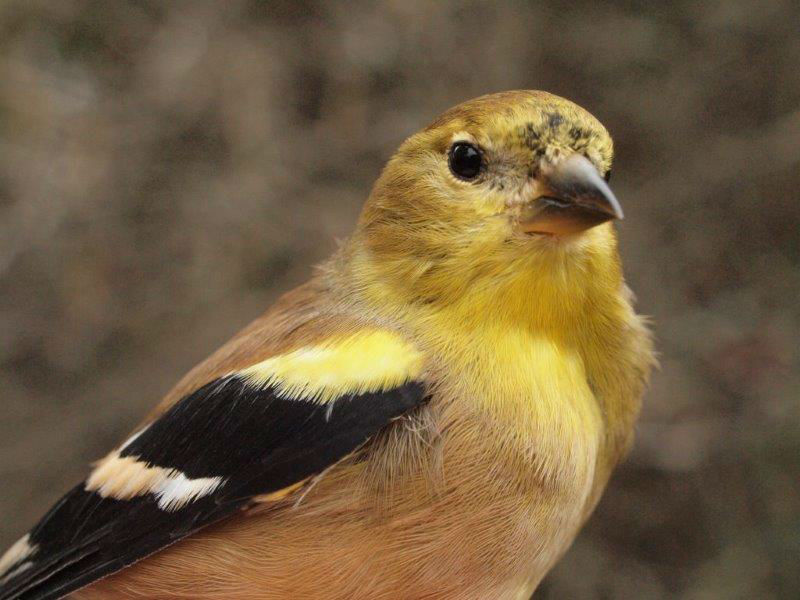
American Goldfinch numbers were up and down over the course of the season; this was the 71st individual banded this fall, which is slightly more than the ten-year mean of 61 for the season (Photo by Simon Duval)
Week 14 (October 31 – November 6, 2015)
| THIS WEEK | THIS FALL | 2006 TOTAL | SITE TOTAL | |
|---|---|---|---|---|
| # birds (and species) banded | 146 (17) | 3151 (84) | 4637 (91) | 57844 (119) |
| # birds (and species) repeat | 36 (9) | 724 (47) | 1032 (61) | 11733 (86) |
| # birds (and species) return | 9 (5) | 66 (23) | 192 (34) | 1864 (51) |
| # species observed | 57 | 151 | 164 | 213 |
| # net hours | 478.0 | 7093.1 | 10583.4 | 113463.7 |
| # birds banded / 100 net hours | 30.5 | 44.4 | 43.7 | 50.8 |
Banders-in-charge: Simon Duval, Gay Gruner
Assistants: Michel Beaupré, Nicolas Bernier, Pascal Berthelot, Marc Boisvert, Zoe Bonerbo, Manon Bourdon, Martha Bromby, David Davey, Katelyn Depot, Marcel Gahbauer, Shannon Gailbraith, Michel Greaves, Alison Hackney, Lorenzo Kleine, Marcel Lebeau, Asya Malinova, Betsy McFarlane, Phillip Mercier, Laura Molina, Paule Schetagne, Jillian Slater, Clémence Soulard, Patricia Stotland, Elise Titman, Rodger Titman, Christiane Tremblay, François Villeneuve, Jesse White
Notes: Last year marked the first time that a 14th week was added to the fall season on a trial basis, recognizing that some of our late season migrants are still moving in large numbers at the end of October and into early November. Given the success of last year’s extension, it was repeated this year. As hoped, we had a couple of good mornings this week, but on the whole witnessed migration tapering off. Species diversity was impressive, with a count of 40 or 41 observed on four mornings this week, and a total of 57. However, on three mornings a dozen or fewer birds were banded. Even with the extra week, the number of birds banded this fall remained below average compared to previous years.
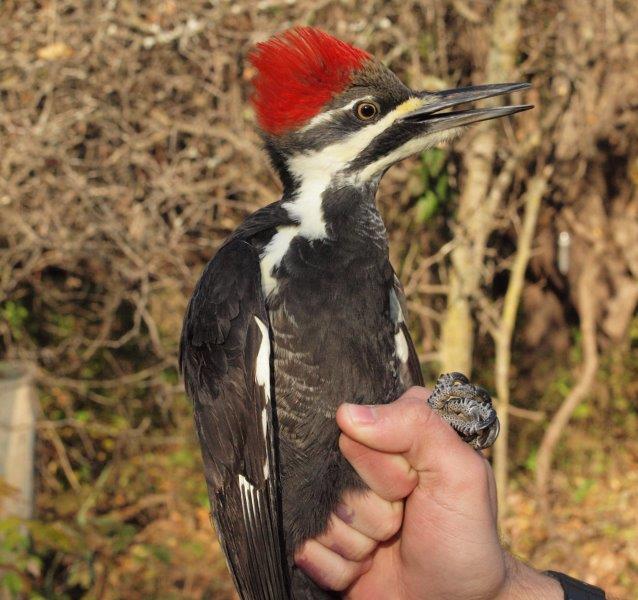
A great way to wrap up fall 2015, with the tenth Pileated Woodpecker in MBO’s 11-year history (Photo by Simon Duval)
The aim of Week 14 is to more truly capture the end of fall migration. It was therefore reassuring to have relatively few “new” species this week, with only Pileated Woodpecker added to the list of species banded this fall (and this year), while Rough-legged Hawk and Common Redpoll were new observations for the season.
| # individuals banded | mean # individuals observed daily |
|---|---|
| 1. American Robin (52) [1] | 1. Canada Goose (612) [4] |
| 2. American Goldfinch (22) [-] | 2. American Robin (570) [1] |
| 3. American Tree Sparrow (18) [2] | 3. European Starling (481) [2] |
| 4. Northern Cardinal (12) [4] | 4. Red-winged Blackbird (189) [3] |
| 5. White-throated Sparrow (8) [3] | 5. Common Grackle (115) [5] |
| 5. Slate-colored Junco (8) [4] | 6. American Crow (58) [6] |
| 7. Golden-crowned Kinglet (7) [-] | 7. Mourning Dove (27) [10] |
| 8. Red-winged Blackbird (5) [-] | 8. Horned Lark (21) [-] |
| 9. Black-capped Chickadee (3) [10 | 9. American Goldfinch (18) [-] |
| 10. Brown Creeper (2) [-] 10. Ruby-crowned Kinglet (2) [4] 10. Purple Finch (2) [9] |
10. Black-capped Chickadee (15) [-] |
Not surprisingly, American Robin remained the top species banded this week, and by a large margin; the season total of 263 ranked second behind only White-throated Sparrow, which with this week’s additions ended up at 326. American Goldfinches returned in numbers this week, enough to reach second place for the week, and ninth for the season. American Tree Sparrow rounded out the top three with a slow but steady presence. The biggest surprise this week was Northern Cardinal, with another dozen banded on top of the 24 earlier in the season, which was already a record. This suggests there was a strong late fall dispersal, something possibly missed in earlier years without full coverage of this week. Despite the season extension, Slate-colored Junco numbers remained low, confirming our suspicion this is a low year for the species. Both kinglets were still around in small numbers this week, and we also banded a modest number of Red-winged Blackbirds and Black-capped Chickadees, plus a couple of Brown Creepers and Purple Finches.
Among species observed, Canada Goose rebounded to top spot this week, narrowly ahead of American Robin. The next five species remained in the same order as last week, although with some minor shifts in abundance. Mourning Dove numbers continued to rise, and reached the second-highest weekly average in MBO’s history. Even more remarkable though was the strong flight of Horned Larks, with more individuals counted this week than in the first ten years of MBO’s history combined! Rounding out the final top ten of fall are two more regular species that had dropped just outside the top ten last week, Black-capped Chickadee and American Goldfinch.
This week also marked the end of our six-week owl banding season. While most other saw-whet owl banders in northeastern provinces and states have been reporting below average counts this fall, the 272 individuals banded at MBO this season is a record for the site, far more than the 235 banded during the same period in 2012. In particular, the final week of the season was unusually productive, with 29 banded this week, compared to a previous record of 16 and a mean of 12 during this period over the past five years. We ended up with 55% hatch-year birds (a far lower percentage than in most “boom” years) and 31% second-year individuals.
We now shift to winter operations until the end of March, with periodic monitoring as weather permits. We will also use this time to complete our report on the first ten years of MBO, as well as the 2015 annual report – watch for announcements as these are published!
